#which! both require VERY different responses but might look similar to a human!
Text
while aaravi remains firmly within "yeah miranda has a difficult personality and isn't very easy to get along with + has many rough edges which are slowly being worked on but still going to be an issue" after having been very much so within the camp that miranda is a Vexing Bitch upon first contact/getting to know her, she DOES go from "miranda is unpredictable and dangerous as a merfolk and large macropredator and her emotions are inscrutable and random" to "merfolk aren't very hard to understand or predict and it's very easy to stay on the safe side if you keep basic rules in mind and don't freak out the second something unexpected happens"
#all the care guide says is 'biomass'#miravi.txt#just. thinking about it!#thinking about specifically how merfolk (like most other animals) growl/hiss specifically as a deterrent#like if you start really upsetting miri and she wants space and you to Please Stop#she will probably turn her face away from the other person or turn her body away from them#while growling or hissing and pulling her fins back#and will open her mouth to bare her teeth or gape her mouth open to show her teeth (including heavily panting)#where the point is ''i will hurt you if you touch me/get closer/dont stop so please dont do that''#but a lot of people read it as her being either obtuse (if she turns away from them)#or outright aggressive for the showing of teeth and growling#when shes really not. shes being very polite in merfolk terms in giving multiple chances to avoid violence#shes going ''i am worried i might have to hurt you so please reconsider'' in a way thats very readable if youre another merfolk#who will then step away or give her her space and switch the tone of the conversation#to see whats wrong#whereas her being more deliberately aggressive/violent usually comes with minimal vocal cues at all#or (if shes specifically threatening someone such as in the case of getting aggressive over perceived threats to her social bonds)#she will often turn towards them and open her mouth and flare her fins#often deliberately closing the distance and making herself appear Extra Large#she WILL growl here but will never hiss (hissing being a more defensive sound)#and will often smack her tail against the ground or show her claws or otherwise demonstrate how large and how scary she is#as a deliberate point of ''you crossed a line and this is what is going to happen to you if you dont make it up right now''#which! both require VERY different responses but might look similar to a human!#and might end up coming off as unpredictable or random in her actions and cruelty!#when shes not! shes just doing things the way a merfolk does them#which means aaravi realizes VERY quickly after learning about all of this#just how many cues miranda gives that people are starting to make her uncomfortable and feel Not Okay#that are ignored or written off because theyre merfolk cues#merfolk are very tolerant of stress but have basically no concept of escalation of violence for that reason#because if youve ignored every chance to prevent something dangerous up until the point it goes too far
18 notes
·
View notes
Text
Edible Atrocities - Naga (With Extras)

@saburo-kyoto Very lovely suggestion!
There is quite a bit here so I apologize for the lengthy read
Culinary Subject: Naga
Naga are distant cousins of the better known Lamia. These two serpentine species share enough of a genetic relation to allow interbreeding, which creates the sexually viable Lamkompra (Half-breeds which combine traits of both parent species).
Naga are a race of humanoid serpents. They sport a humanoid upper body (at least in shape) and move about on a serpent tail. They can slither at a reasonable pace, but when feeling the need to rush, it is not uncommon for them to utilize the use of their muscular arms to propel themselves forward at heightened speed.
Where the Lamia have upper bodies that perfectly mirror the appearance of human women, save for slightly pointed ears and unusual looking eyes, the Naga do not have that luxury. Their upper bodies, while humanoid in shape, are covered in scales. Their heads also better resemble that of the Cobra, right on down to the presence of the elaborate frilled hood that the serpents are best known for.
Unlike their cousins the Lamia, the Naga come in both male and female variants (with the females being noticeably larger due to a wonderful thing called sexual dimorphism). They come in a range of colors and patterns, with different social groups generally sharing a similar appearance.
They are incredibly venomous and capable of easily hypnotizing the average human, thus making them risky to approach. However, as a high-intellect "human adjacent" race, they can be safely interacted with if approached respectfully.
Contrary to common stereotypes, the Naga are not an inherently hostile race which preys upon humans. They are simply a race of creatures which largely seeks to protect their home and territory from unwelcomed invading forces, which has likewise led to many conflicts due to humans competing with them for resources.
The majority of the conflicts between humans and Naga are founded upon the the false belief that humans can simply stake claim to whatever resources they happen across out in the wilderness; regardless of the presence of native creatures which might be equally reliant on those resources.
Author Notes: As a rule of thumb, my associates and I prefer not to hunt creatures that are considered "Human adjacent". That being any race of human intellect (or greater) that is capable of producing sexually viable young with humans.
However, there are rare circumstances in which a Naga establishes themselves to be enough of a threat that execution is warranted, at which point the edible parts are harvested and any inedible remains are respectfully disposed of.
In most cases though, the tail of the Naga can be obtained without dealing lethal damage to individual.
This does not mean that the process is pleasant, as the tail is most often severed in the midst of fierce combat or in response to extreme stress. It is not dropped like the tails of many lizards, and legitimately requires effort in order to break off.
That aside, the Naga are adapted to allow them to safely lose up to a third of their tail without enduring serious damage. This is an adaptation that has been present in the species for a while, likely as a byproduct of their own cultural behaviors, as well as the need to escape capture from other races. Better to willingly disconnect a few pounds of flesh than to lose ones own life, after all. Especially when that flesh can be recovered over the course of a couple of years.
Recipe Index:
Snake Cheese
The many uses of Naga tail
Bonus subject: Mandragora
Mandragora
Mandragora Bulbs
Bonus subject: True Slime
Slime essence
/\/\/\/\/\/\/\/\/\/\/\/\/\/\/\/\/\/\/\/\/\/\/\/\/\/\/\
Naga Recipes
Snake Cheese:
A naturally soft and spreadable cheese with a distinct flavor. Tangy, with faint buttery notes and a hint of toasted pistachios. Pairs wonderfully with smoked meats and sweet jams! Can be enhanced through the addition of herbs and spices.
You will need:
- 1 gallon milk (preferably cows milk)
- 1 ounce Naga venom
- 1 tablespoon salt
Equipment:
- A large pot
- Leather gloves
- A wooden mixing spoon
- A large bowl
- Cheesecloth
Before you begin to prepare this recipe, be sure that you have collected a fresh sample of Naga venom (which is generally easy to obtain. I've found that they find it amusing that I use their venom to make cheese) and a suitable place to store your cheese while it ferments.
To prepare a batch of Snake cheese, you begin by pouring 1 gallon of fresh milk into a suitably sized pot. Place that pot over a low flame, and carefully bring the milk to a low simmer while mixing continuously. Do not boil.
Continue to simmer the milk for a period of 1 to 2 minutes, then swiftly remove the pot from the flame.
Take your ounce of Naga venom and pour into the milk. (Be mindful not to spill any on yourself, as the venom is quite hazardous. If it gets into a cut, it can lead to rapid rotting of the surrounding tissues, and if it somehow finds its way into the eyes it can lead to permanent blindness without swift intervention.)
You should notice that the milk immediately begins to curdle. This is what you want! Stir the curdled milk for upwards of a minute, before removing your utensil entirely.
Sprinkle in your salt then allow your cheese mixture to sit undisturbed for no less than ten minutes (the Naga venom is most potent at this time).
Once the appropriate amount of time has passed, dawn your protective gloves.
Arrange your cheese cloth so that it wraps around the interior of the bowl. Leave enough extended along the rim for you to easily grab. Then carefully spoon your cheese mixture into the bowl.
At this stage, it will be very gelatinous due to retained moisture. This is normal. Just be sure to get all of the solids out of the pot.
Once you have completely isolated your cheese mixture, carefully take the outer edges of the cheesecloth and twist until you have formed a tight ball.
Quite a bit of whey will drain as you do this. Be mindful not to spill any on your clothes, as the venom is still active and could lead to injury.
Secure this tight ball of cheese with a knot and hang it over the bowl. Be sure not to hang it high enough that dripping whey will splash, but not so low that it could come into contact with anything in the bowl.
Leave the cheese alone like this for 24 hours. Do not touch or disturb it during this time while it drains and undergoes its first stage of fermentation.
While the cheese is resting, now is the time to begin disposing of any liquid left behind in the pot.
Do not drink this liquid. Do not get it on your skin. Do not dump it into an accessible water supply. Do not pour it into the dirt.
To safely dispose of this envenomed whey, take the mixture and bring it back to a full bowl. Then allow the mixture to boil down until it has become a thick sludge that coats the bottom of the pot.
Mix ashes into this sludge, and then bury it. The heat from the prolonged boil will have destroyed most of the enzymes in the venom, while the ashes with neutralize anything that is left.
Be sure to thoroughly clean your pot and cooking utensils once done. Wash it at least three times to assure than any remaining venom has been completely washed away.
After allowing your cheese to sit for at least 24 hours, all excess whey should have successfully drained. Dispose of this whey the same way that you disposed of the whey from the pot, or pour directly into a raging fire and trust that the flames will destroy the venom.
From here, all that you must do is wait.
Store your cheese in a cool, dry place and wait for a period of 6 to 10 weeks while the enzymes in the venom slowly process the milk solids.
The cheese will not be safe to eat unless aged for the minimum of 6 weeks. Any fermentation past that point will simply act as a means of further aging the cheese, which allows it to develop a more intense flavor.
Once the fermentation process is up, you will be left with a delightfully soft cheese that spreads like thick butter. It can be eaten as is, or combined with various herbs, spices, or even fruit in order to promote a desired flavor.
The resulting cheese, without additional flavorings, tastes vaguely of butter and has a noticeable acidic note to it. The aftertaste is comparable to toasted pistachios. It is quite pleasant.
-------------------------------------------------------------------------
- The MANY uses of Naga Tail -
Obtaining the tail of a Naga can be quite risky. Those seeking to legitimately hunt these creatures must take care to properly prepare themselves. Venom resistant potions are a must and hypnosis-resistant gear is greatly advised. As is durable metal armor if one wishes to avoid being potentially crushed by the powerful muscles of these giant snakes.
A mixture of sharp and blunt weapons will work best at dispatching a Naga if the ultimate goal is to take their life. Using blunt weapons to deliver powerful strikes to the head and chest can incapacitate a Naga, whereas the sharp instruments will make delivering the lethal blows easy enough. Just be sure to thoroughly restrain or otherwise dismantle the head and jaw of the serpent, as it retains the ability to fight for days after battle even if disconnected from the body.
Those who seek to obtain a tail through less lethal means may find themselves having an easier time. Certain tribes are willing to trade hefty portions of their own flesh if offered valuable resources, like metal. Others will only part with their tail if first defeated in battle, in which case you must be prepared for a fight if seriously looking to sample this particular type of meat.
During certain times of the year, particularly around mating season or during periods where rites of passage are due to take place, these tails can be more easily obtained.
During the mating season, males often lose portions of their tail while competing for the attention of females. Juveniles of both sexes often lose their tail when fighting for the right to reach adult status.
During these points in time, the Nagas will generally be willing to sell these disembodied tails for a fair price. They can be obtained through bartered trade or through legitimate sale. This will be the safest means of obtaining the meat of a Naga, though visitors must be warned that they are expected to respect the culture of their hosts.
Any perceived as being disrespectful may find themselves being put up on the menu if they fail to plead their case.
The flesh of a Naga's tail is dense and loaded with intramuscular fat. It responds well to a wide array of cooking methods, though some methods will require more prep work than others.
The meat itself falls somewhere between red and white meat, being naturally dark-pink in hue when raw and turning a lighter shade of pink when cooked. The texture is closest to that of pork, and in terms of flavor it is surprisingly neutral.
Unseasoned, browned meat tastes similar to chicken. If unseasoned meat is prepared in a way that does not allow it to brown, then it will not develop much of a flavor and will wind up unpalatable as a result.
The meat of the Naga must be adequately seasoned and great care must be put into preparing the meat in order to assure that a recipe comes out as delicious as it should. While this will take effort, the end result is well worth the time put into each dish.
-------------------------------------------------------------------------
Naga Tail (Smoked):
A wonderfully tender portion of smoked meat, given a great amount of flavor using various seasons. Perfect as a quick snack or as an addition to a wide range of dishes! Can be used to make sandwiches, added to pasta to add flavor, or even mixed into scrambled eggs to create a hearty breakfast - and so much more!
Comes in lightly sweetened and traditional varieties.
You will need:
- 5 pounds of Naga tail meat
- 1 tablespoon each of Salt, Pepper, Garlic, and water
- 1 tablespoon each of Brown sugar, citrus fruit (the zest and the juice), and optional ginger (for a sweet smoked meat)
- 1 tablespoon each of Mustard, vinegar, onion, and paprika (for a more traditionally flavored smoked meat)
Equipment:
- Metal smoking rack with a cage
- Suitable smoking wood
- Knife and cutting board
- Large bowl
- Measuring utensils
To begin, prepare a suitable place to build your fire and assure that the weather will be clear for the day. You will not want to prepare this recipe on a windy day or on a day where rain is a potential risk factor.
Once your fire is built, move on to the next step.
Prepare your portion of the meat. You can use a sharp knife to remove the skin and scales, and this can be done fairly easily. Simply press the tip of the knife into the exposed flesh where the tail was disconnected from the body. Insert about an inch, and then cut upward to create a break in the skin. Once the break is present, you will be able to easily work your fingers between the skin and the meat. All that you will need to do from there is pull. The skin will peel right off!
If needed, you can also cut along each side of the break to create loose flaps. This will make keeping a good grip on the skin much easier.
As a full tail segment from a Naga will generally weigh somewhere between 125 to 175 pounds (nearly a third of the average weight of a Naga), it is recommended to not peel back more of the skin than is needed to expose your desired portion of the meat. The skin helps keep preserve the flesh and prevents decay from setting in, for a time.
Once you have the flesh exposed, find the space between two segments of the tail vertebrate and jam your knife into it to break the bone. This will allow you to easily cut away your desired portion of flesh.
You will also want to cut out and remove any bones that are found throughout the meat. The tail will most often contain a portion of the Nagas spine, and each segment of the spine is in turn supported by a pair of arched, rib-like structures.
If your tail does not appear to have the spine or ribs but instead seems to be supported by thick bands of tough red tissue, then you're in for a treat. You have the tail of a Naga that has already shed its tail in the past, and so the flesh is younger by comparison. The meat will be even more tender than usual once the recipe has been completed.
These bands of tough tissue will need to be removed though as they are not suitable for human consumption.
Once your tail meat has been cleared of any inedible bones or tissues, it is ready to be smoked.
To prepare your seasoning mixture, combine all of the desired ingredients into a large bowl and mix them together thoroughly. The end result should be something of a runny paste. One that easily coats your fingers in an even layer without bunching up or clumping.
Once this seasoning paste is ready, place your chunk of meat into the bowl. Roll the meat around while using your hands to rub the seasoning into the muscle fibers. Do not be afraid to use force. You, quite literally, need to massage the meat. One that is done, then you must allow the meat rest for ten minutes.
Repeat the seasoning massage twice more, allowing the meat to rest ten minutes between each session. This will allow the seasoning to permeate the flesh, and assures that very little will be wasted.
Once your meat has been thoroughly seasoned and massaged, you will notice that it has softened as a result. That is the value of a good massage!
With your seasoning now ready, secure your tail meat within the confines of the smoking cage. Use skewers or cooking thread as needed if the meat does not properly fit inside. Then hang the meat up on the rack.
For the next six hours, your only ambition in life is to maintain your fire so that your meat will cook.
Rotate the meat every thirty to forty five minutes to assure that the heat is evenly spread. This also allows for the creation of an almost charred crust, which is absolutely packed with flavor. This crust prevents excess liquid from escaping the meat, which in turn keeps the meat moist.
Once this six hour smoking period is done, remove the smoking cage from the rack and set in a sanitary environment.
Do not attempt to remove the meat from the cage for at least two hours. Do not attempt to cut into the meat for at least four. This will assure that the meat has the chance to settle and properly absorb the flavorful juices that it would lose if cut too early. Thus you will prevent the meat from going dry by letting it rest before you dig in.
Once all of this is done, then you will be free to indulge in this delicacy.
-------------------------------------------------------------------------
Naga Tail (Grilled):
Succulent meat with a delightfully savory taste. Tender, but firm enough to awaken the dormant carnivorous urges that hide within us all. Simple and easy to make.
You will need:
- 1 pound Naga tail meat
- 1 teaspoon each of salt, pepper, garlic, onion, and paprika
- Parsley and/or chives, to taste
- The juice of 1 orange
- Oil
Equipment:
- Knife and cutting board
- Grilling stand
- Grilling utensils, like tongs or a carving fork
- Measuring utensils
- Large bowl
To begin, prepare your grilling station. Build a suitably sized fire and allow your standing grill to heat up. Be sure to season thoroughly with oil to assure that your meat will not stick!
Once your grilling station is ready, prepare your portion of the meat. For instructions on how to cut a portion of the tail for consumption, refer to the previous recipe. Just note that removing the bones will be optional for this recipe, as the meat is going to be moved around quite a bit and the bones will provide support.
Once you have the tail meat, place it in a large bowl. Squeeze in or otherwise add the juice of 1 whole orange. Massage the juice into the meat, then allow to sit for fifteen minutes while the acid in the orange juice does its magic.
When that is done, measure out all of the listed seasonings and add them to the bowl.
Massage the meat again. Thoroughly. Be sure to get the spices evenly distributed across every nook and cranny that exists upon the flesh. Apply a little oil to the meat if needed to help assure that nothing is left unseasoned.
After your meat has been thoroughly prepared, you're ready to grill.
Take the tail meat and place directly on top of your grilling rack. Allow to sit undisturbed for two minutes, then flip and grill for another two minutes.
From here, continue to grill for another ten minutes, flipping every one and a half to two minutes. As you do this, the meat will develop lovely grill marks and a nice char, which will just add to the flavor.
When the meat is cooked through and the outside is nicely seared, remove from the heat. Allow to rest for at least ten minutes to assure that the meat can baste in its own internal juices. Sprinkle with fresh herbs, then enjoy!
Can be eaten by itself, though it will pair wonderfully with roasted vegetables or fresh greens!
-------------------------------------------------------------------------
Naga Tail (Braised):
Looking for something reminiscent of pulled pork, but don't have access to pork? This is the recipe for you! A long cooking time in a flavorful cooking liquid allows all of the intramuscular fat of the tail meat to melt away, leaving behind an addictively savory treat.
You will need:
- 5 pounds Naga tail meat
- 2 onions, quartered
- 1 bulb garlic, roasted
- 2 large carrots, grated
- 2 cups beer or ale of your choice
- 1 cup apple cider vinegar
- 2 tablespoons each ground mustard seed, paprika, chili powder, salt, and pepper
- Half a cup brown sugar
Equipment:
- Large braising dish with a lid
- Knife and cutting board
- Cheese grater
- Measuring instruments
- Large bowl
- Whisk
Note: This recipe is best prepared in an oven, though it can be prepared over a campfire. The process will just be more tedious.
This recipe requires a fair amount of prep work. There are multiple vegetables that must be thoroughly cleaned and cut.
The carrots must be peeled and grated.
The onions must have their inedible outer skins removed and they must be quartered.
The garlic, of which you will be using an entire bulb, must be carefully roasted until fragrant and soft. To properly roast your garlic, you can cut off the top portion and slather liberally with oil. Place the bulb in a small dish with a lid, and cook over low heat for 45 minutes to an hour. The resulting product can be easily squeezed from the skin, directly into the main dish.
Additionally, the spices are best if fresh ground, but pre-ground will be fine.
To begin, heat your cooking area. Preferably an oven. A campfire will suffice in a pinch.
Prepare your portion of tail meat. Refer to the recipe for "Smoked Naga Tail" for an in-depth explanation of how to easily remove a chunk of flesh from the tail segment. Be sure to debone.
Place the tail meat directly into a deep braising dish. If the lone chunk is so large that it would inhibit the ability to properly close the lid, divide the meat into two equally sized pieces to make more room.
Place the onion quarters and the grated carrot into the braising dish. Be sure to spread everything out.
In a separate bowl, combine all of the dry seasonings. Squeeze in the roasted garlic, and mix to create a paste. Then pour in the apple cider vinegar and thoroughly combine.
Add the beer or cider to the bowl, along with the brown sugar. Whisk once more until all of the sugar has dissolved. Then take this liquid and pour all of it into the braising dish with the meat and vegetables.
Cover with the lid, and move to the heat.
The dish must cook over a low flame for a period of 4 to 6 hours. Remove from heat every 2 hours to disturb the mixture, to assure that everything is properly being broken down as it cooks.
What begins as many separate ingredients will gradually be broken down into an almost homogenous mixture of shredded meat and vegetables, which will be absolutely saturated in a rich broth.
Once all ingredients have been properly broken down, remove the lid and allow to cook for another 1 to 2 hours, or until the broth has reduced by half and taken on the consistency of runny gravy.
No need to allow to sit for hours on end. Once the meat has finished cooking, the only thing keeping you from eating it is your ability to tolerate hot food.
Can be eaten as is, though it pairs wonderfully with Mandragora Mash (refer to "Mandragora" segment). It also makes for a wonderful sandwich when served on Mandrabread (again, "Mandragora" segment) with a crisp slaw.
-------------------------------------------------------------------------
Naga Tail (Fried):
Firm and chewy chunks of fried tail meat, which have been seasoned appropriately and given a crispy crust. Savory, salty, and oily, this dish makes for an addictive snack that is best enjoyed with friends! Tastes like fried chicken.
You will need:
- 1 pound Naga tail meat
- 2 ounces slime essence (or large 1 egg)
- 3.5 cups fresh breadcrumbs
- Quarter cup of flour
- 1 teaspoon each of salt, pepper, onion, garlic, and paprika
- 4 cups oil, plus 1 tablespoon
- Dipping sauce of your choice (optional)
Equipment:
- Deep pot
- Tongs
- Knife and cutting board
- Measuring utensils
- 2 bowls
To begin, prepare your cooking oil by adding it to a deep pot and setting it over a low flame. Allow the oil to heat completely before attempting to cook, as oil that is not to temperature will result in your fried meat developing a soggy crust.
Prepare your portion of tail meat. Refer to the recipe for "Smoked Naga Tail" for an in-depth explanation of how to easily remove a chunk of flesh from the tail segment. Be sure to debone and cut the meat into bite-sized chunks. Cover these chunks of meat with oil.
In a moderately sized bowl, combine the seasonings and the flour. Add in your oiled chunks of tail meat, and thoroughly mix to assure that all meat is covered. Discard any seasoning mix which has not stuck to the meat.
Pour the slime essence over the meat (or add in 1 beaten egg). Do not mix.
Fill your second bowl with breadcrumbs, and then begin adding in your seasoned tail meat. Do this one piece at a time, and be sure to thoroughly cover eat piece in the breadcrumbs by gently jostling the bowl. Be mindful not to disturb the pieces too much as the breading may come off.
Once all of the meat chunks are breaded and buried in the crumbs, allow to sit for 5 minutes. This will assure that the slime essence (or beaten egg) fully adheres to the meat, which in turn assures that the bread crumbs will stick.
Once the batter has settled around the meat, remove the chunks one at a time and carefully place into hot oil.
Fry for three to five minutes, or until all sides have formed an evenly brown crust. Then remove from oil and allow to drain.
Serve as is, or pair with a dipping sauce of your choice.
(Authors Note: I like to dip these morsels in herb infused Snake Cheese)
-------------------------------------------------------------------------
Naga Crackling (Fried Naga skin):
An addictive snack made from strips of serpentine skin, which have been deep fried and given a puffy, crispy texture similar to that of Pork Rinds. The taste is akin to that of fried chicken skin.
You will need:
- Naga tail skin, descaled
- 1 cup oil
- Salt and pepper, to taste
Equipment:
- Shallow saucepan
- Cooking tongs
- Knife
To begin, pour your oil into a shallow saucepan and bring to temperature. If the temperature is not high enough, then the skin will fail to puff up and will be left soggy as a result.
Take your portion of tail skin and prepare it for cooking. To remove the scales, quickly dip the skin into boiling water, then immediately place in ice water. This shocks the skin and prompts the scales to dislodge with ease. They can be removed by hand or scraped off with a knife.
Once the tail skin has been descaled, but it into strips. Roughly one inch wide and 2 to 3 inches in length. Do not season.
Pat the skin with cloth to assure that it is free of excess moisture. Then take these strips of skin and carefully deposit them into hot oil, 2 to 3 at a time, and allow to cook.
The skin will bubble and expand, reaching 3 times its original thickness. You will know that it has finished cooking when it has turned golden-brown. At which point it must be immediately removed from the oil and allowed to drain.
Season with salt and pepper while hot, or with any other dried seasoning that you may fancy.
Can be immediately eaten as once cool enough to be tolerated by the human tongue. Can also be paired with dipping sauce of your choice, or used as a delightful crunchy topping for salads!
-------------------------------------------------------------------------
Sweet and Savory Naga Stew:
You will need:
- 2 pounds Naga tail meat
- 1 pound Mandragora Bulbs, deseeded and quartered
- 4 ounces Slime essence (or 4 egg yolks)
- Half pound each of carrot, onion, celery, potato, and small tomato, all cut into chunks.
- 2 teaspoons each of salt, pepper, (freshly chopped) garlic, parsley, and (freshly chopped) ginger.
- 1 tablespoon oil
- 8 to 10 cups water
Equipment:
- Deep cooking pot, or cauldron, with a lid
- Knife and cutting board
- Large bowl
- Measuring utensils
- Cooking tongs and cooking spoon
Note: A fair amount of prep work will go into this recipe. The vegetables must all be thoroughly cleaned and cut into bite sized chunks.
The potatoes and the carrot must be peeled.
The garlic and the ginger need to be fresh, or the final flavor of the gravy will not be as complete. All of these things are vital and only make up a small portion of the prep that will go into preparing this dish.
To begin this recipe, first you must prepare your portion of tail meat. Refer to the recipe for "Smoked Naga Tail" for an in-depth explanation of how to easily remove a chunk of flesh from the tail segment. Be sure to debone and cut the meat into bite-sized chunks.
Cover these chunks of meat with oil, and brown unseasoned in your cooking pot or cauldron until nicely browned on all sides.
Remove the meat from heat and set aside. Then add your fresh garlic and ginger directly to the pot, and cook until lightly browned and aromatic (move the pot off of the heat temporarily if this will prevent you from burning the ingredients).
Once the garlic and ginger are browned, add in all of your vegetables. Carefully agitate these vegetables for 1 to 2 minutes to allow them to begin to cook, while covering them in the fat and seasoning that have been deposited in the bottom of the pot.
Once you begin to see some color forming on your vegetables, return the meat to the pot and carefully mix in. Then slowly add in the first half of your water.
Allow the mixture to come to a simmer. As you do, combine your remaining seasoning with the remaining water. Additionally, mix your slime essence (or egg yolks) into this seasoned water mixture.
Once the main pot has come to a simmer, slowly add in your seasoned water mixture. (Note: If you utilized egg yolks, you must first add 1 to 2 cups of heated broth from the pot to the main water mixture in order to temper the eggs. Otherwise your broth will wind up full of scrambled egg strands). You will notice that the main mixture immediately begins to thicken, which is what you want. The final consistency of the broth will be akin to that of slightly runny gravy.
Place the lid on top of the pot, and allow to cook for 1.5 to 2 hours, stirring every 30 minutes or so. The stew will be finished when the vegetables are all tender and the meat begins to fall apart.
Serve as is, or with a side of buttered Mandrabread Rolls (refer to "Mandragora" segment).
/\/\/\/\/\/\/\/\/\/\/\/\/\/\/\/\/\/\/\/\/\/\/\/\/\/\/\
Bonus: Mandragora and their edible parts
Authors Notes: Not to be mistaken for the Mandrake, which are an independent species of plant monster with a similar name. The Mandragora is the naturally occurring species of plant monster which spends its time hidden in the ground and wails like an infant when uprooted. The Mandrake is the man-made species created through alchemy.
Mandragora are a small, non human-adjacent species of monster with the intellect of a turkey. Mandrakes are a human-adjacent species that form societies of their own in the wilderness. They are not to be mistaken for one another or treated the same.
HOWEVER, this difference is not an excuse to treat the Mandragora with any less respect than any other living creature. Uprooting them causes them intense stress (thus the wailing) and they are capable of feeling pain. Thus, harvesting these creatures for their edible parts must be done with care, so as to not harm or over-stress them.
-------------------------------------------------------------------------
Mandragora:
Mandragora are best tracked during the day, when the creatures have buried themselves in the earth and gone to sleep. This will reduce the risks associated with hearing a Mandragora's scream, such as developing Mandragora Psychosis.
Mandragora are notoriously difficult to track, due to their innate ability to blend in with the surrounding foliage. So the best chance at finding them is to look for the bright orange bulbs that they produce during the late spring and early summer.
Once you have located a suspected Mandragora, you can easily authenticate its presence by tickling the underside of the leaves found growing around the bulbs.
If the leaves curl or otherwise shy away from your touch, then you've found a Mandragora. If they do not, then you've unfortunately just found a run of the mill mandragora bush. Which part of the nightshade family and is therefor highly poisonous, so you should not try to eat it.
Once you have located a Mandragora, what you do will depend on what your end goal is.
The orange bulbs are edible and can be easily harvested without killing the creature. But these bulbs should be harvested with care, as they serve as the primary means of reproduction. Each bulb could potentially go on to become a new Mandragora, and so overharvesting could be a detriment to the species.
If harvesting the bulbs for consumption, look for any with unusual coloration or size. Bulbs with green or brown hues are sterile, or otherwise considered duds. So any Mandragora born from these would be incapable of reproduction. Likewise, undersized and oversized bulbs will give rise to sickly and deformed mandragora, which will be unlikely to survive into adulthood.
Harvest these genetically non-viable bulbs for cooking purposes. This allows you to make use of your harvest which giving the healthier bulbs the chance to grow stronger, which will lead to small booms in the Mandragora population.
If the goal is to harvest the whole creature, then first remove the healthiest bulbs to plant them in the immediate area. This will assure that you'll have high chances of finding more Mandragora in the same area in a couple of years.
To safely dispatch a Mandragora, do not dig it up. This will cause undue stress to the creature and risk you getting injured. The best means of slaughtering these creatures is to take a long, sharp object (like a pick) and drive it directly into the central point of the leaves.
So find the main point where all of the leaves connect to the head, which is submerged in the soil. Locate the center, and then position your tool. It will only take one swift, downward motion.
You will need to use a fair amount of force, as you will need to drive your tool at least 3 inches deep in order to fully kill the creature. You will know that you have done this correctly if all of the surrounding leaves suddenly go limp.
Once this is done, you will be free to dig up the Mandragora without fear of its screams. Then you will be able to do with it and its bulbs as you wish.
-------------------------------------------------------------------------
For full detail recipes on how to prepare Mandragora for consumption, refer to the Mandragora Recipe guidebook.
- Mandragora Mash:
A savory paste made from the pulverized body of the Mandragora. Similar to mashed potatoes in texture due to high starch content, but with flavors reminiscent of roasted garlic and honey. Peculiar, and yet still pleasant on the palate. Requires nothing but salt to create a delectable dish.
- Mandrabread:
A type of naturally leavened bread created from Mandragora Flour, which is in turn created by drying out a whole specimen and then grinding it into a fine powder. This bread has a distinct chew to it and develops a dark brown crust, while retaining a white interior.
-------------------------------------------------------------------------
Mandragora Bulbs:
The fetal form of the Mandragora, which are carried in a cradle of leaves atop their parents head. These bright orange fruit are rich in nutritious sugars and starches, which are meant to be used as a means of feeding the developing baby once the time comes for it to be buried by its mother.
Cut open the fruit to discover the tiny fetal forms of the Mandragora. Only the size of a pecan, and resembling a tiny tangle of roots with a face, they cannot survive long without the nourishment of the fruit unless given immediate care.
These fetal Mandragora can be cared for in the long-term if moved into a dark, damp box and provided regular feedings of fruit and vegetable slurries (which need only be dripped down into the soil that they rest upon). Once large enough, they can be moved onto a diet of fresh fruit and insects. They make for surprisingly docile pets if raised from scratch.
Otherwise, they can be easily dispatched with a light squeeze between the index finger and thumb.
I would not advise leaving the little creatures to die of natural cause, as the process can take hours and undoubtedly causes undue stress to the helpless creature.
The fetal forms are fully edible and can be eaten raw. Or they can be toasted whole, at which point they will taste akin to honeyed sunflower seeds.
-------------------------------------------------------------------------
For full detail recipes on how to prepare Mandragora Bulbs for consumption, refer to the Mandragora Recipe guidebook.
- Compote of Mandragora / Mandragora Jam: Sliced and simmered fruit of the Mandragora, sweetened through the addition of honey or sugar. Leaving the fruit mostly intact creates a compote that makes an excellent topping for cakes and breads. Thoroughly crushing the fruit as it cooks creates a spreadable jam.
When prepared this way, the fruit takes on a taste comparable to browned butter and caramel, with faint figgy notes. Suits the palates of a wide range of people.
-------------------------------------------------------------------------
- Dried Mandragora Fruit: Halved fruit of the Mandragora, dried with a mixture of salt and sugar. This dried snack has a naturally chewy texture, and is understandably both sweet and salty due to the drying process. Tastes similar to dried apples and apricots.
-------------------------------------------------------------------------
- Candied Mandragora Fruit: De-seeded, whole Mandragora bulbs cooked for hours in a mixture of honey and water over low heat. These sinfully sweet delights take a full day of carefully maintained cook time to create, and are meant to be eaten once in a blue moon due to their heightened sugar content.
They have the texture of a firm custard, or a bread pudding, and taste strongly of caramel.
-------------------------------------------------------------------------
- Mandragora Syrup: A tangy, buttery syrup made by soaking sliced Mandragora fruit in sugar. The resulting extract is then simmered to better amplify the flavor, creating a condiment that makes for a wonderful addition any recipe that could use a hint of sweetness!
-------------------------------------------------------------------------
- Grilled Mandragora Bulb: The halved fruit of the Mandragora, seasoned with olive oil and salt and grilled over an open flame. It has a surprisingly meaty texture, and savory notes reminiscent of cooked mushroom shine through the otherwise sweet and buttery taste.
/\/\/\/\/\/\/\/\/\/\/\/\/\/\/\/\/\/\/\/\/\/\/\/\/\/\/\
Bonus: True Slimes (yes, they're edible)
Authors Note: An important distinction to make; True Slimes consist of a family of amorphous, gelatinous blobs that lack any distinguishing physical features. They do not have eyes, mouths, or internal organs. Their origin can be traced back to alchemy, though the process of their creation is unclear.
True Slimes differ from other creatures that fall into the "Slime family" due to their complete lack of physical features and their man-made origin. Other entities in the slime category often have eyes, mouths, and organs. These False Slimes are completely different from their man-made counterparts, and thus require different means of capture and preparation.
If out to harvest slime essence, be sure that the creature that you are harvesting is a True Slime. Otherwise, you pose the risk of torturing an innocent creature and poisoning yourself by consuming an inedible substance.
-------------------------------------------------------------------------
True Slime:
True slimes are as common as dirt and are therefor incredibly easy to locate. They are also easy to deal with once encountered, if someone knows the proper method.
There is little reason to use excessive force or to put ones self at risk when encountering one of these creatures. All that is needed is a good blunt object with a fair amount of surface area, and a good amount of salt.
Yes. Salt.
The outermost membrane of a slime behaves much like the flesh of a gastropod. If given a thick coating of salt, this membrane fizzles away and takes with it the slimes ability to maintain form. They will quite literally melt, which leaves behind the edible essence that you are looking to collect.
So just apply a generous handful or two of salt and if needed, give the creature a strong smack with a blunt object. It will quickly be reduced to a puddle that is incapable of recovering form and thus will quickly "die".
While such an action would be cruel if used on gastropods, like slugs and snails, I do not consider it as such with the True Slimes. These creatures somehow exist in a state less complex than that of the Jellyfish, yet establish themselves to be invasive and destructive pests that claim hundreds of lives every year.
They have no organs. They reproduce asexually, generally after being damaged and broken into smaller pieces, and thus spread like wildfire if improperly dispatched. They have no means of feeling pain or pleasure, and do not react with distress to stimuli of any form. Thus the notion of cruelty when dealing with these creatures is a personal moral dilemma at best.
-------------------------------------------------------------------------
- Slime Essence:
The edible essence of true slimes. Thick like mucous, and mostly made up of water, one would assume that it is basically without nutritional content.
That assumption would be wrong.
Considering that all that a slime does is aimlessly roam around its environment and consume everything that it comes into contact with, a good portion of this viscous fluid is made up of a wide range of perfectly suitable nutrients. Sugars, starches, and proteins are all present in near equal amounts in slime essence, with them only being outweighed by the higher water content.
Roughly 45% of the composition of slime essence is made up of a mixture of sugar, protein, and starch. Which in turn makes it an excellent replacement (or addition) to a wide range of recipes, generally as a binding agent.
It can replace eggs and fats in baked goods. It creates a wonderful thickening agent if mixed into soups or syrups. Small amounts of it can even be dissolved in water to create a beverage that is better at hydrating overworked bodies. The uses are vast! Which tends to come with the territory for things that seem bland and unappetizing on their own.
#Edible Atrocities#Naga#Ft Mandragora#Ft True Slime#content warning for eating monsters#content warning for eating BABY monsters
3 notes
·
View notes
Note
What are your headcanons for the rest of Bergil's family? When I was younger I always imagined that maybe his mom was pregnant when she was sent away during the war, and then after she came back Bergil had a little sister. I think Iorlas is his mom's brother? and his grandfather in Lossarnach is his mom's dad. Iorlas and Beregond get along great. No idea what Beregond's side of the family looks like aside from "dad exists". Any thoughts? ~meg
Okay so I DID write an answer to this a couple days ago when you first sent it, Meg, but then tumblr ate my reply and I was too frustrated and busy and in pain to try to write it again. BUT I'M BACK!! LET'S TALK ABOUT MY FAVORITE GONDOR FAMILY!
Oh dude I am so glad to hear I'm not the only one who headcanons that Bergil has a baby sister! I dunno what it is about Beregond, but he just gives me "has a daughter" vibes, y'know? Like dads who've only raised boys are one way, but dads who've raised girls just have something different about their personalities, and I think Beregond has that.
Originally I thought that Bergil's baby sis was just a couple months old when the women and children had to leave Minas Tirith, but I think I like your take on it even more...just the constant anxiety thrumming in the back of Beregond's mind like "my wife is with child and I have to get out of this war alive so I can meet my new son or daughter" is just.....mmm. *chef's kiss* Tasty tasty angst, you love to see it.
*hums under my breath* Gotta go, gotta get the job done, gotta start a new nation, gotta meet my son—TAKE THE BULLETS OUT YO GUN—
I think it's a safe guess to say that Iorlas is Bergil's maternal uncle. Families in LotR tend to pass down similar names (Baranor, Beregond, Bergil...Eomund, Eomer, Eowyn...Arathorn, Aragorn...you get the drift), so everyone on the paternal side of the family—that is, Beregond's side—probably has names that start with B.
.......Which then gives us a bit of a clue what Beregond's wife's name might be!! It probably starts with "Io"! And their daughter's name might too. 8-D
(LotR language nerds, what's a good feminine suffix for a Gondorian name?? Asking for a friend. Totally don't need it for fic writing or anything *cough* And don't say Ioreth, that one's already taken.)
It's also probably a safe bet that the maternal side of the family comes from Lossnarch. Beregond was probably born and raised in Minas Tirith, and when he got married, his wife came to live with him in the city.
ABSOLUTELY Beregond gets along great with his in-laws, how could he not?? :-D Bergil seems to speak of Iorlas as if he's a constant fixture in his life, so Uncle Iorlas probably comes to Minas Tirith pretty often. Maybe on business? Perhaps he has a job that requires a lot of travelling, like a postal courier? And sometimes Beregond and Bergil and the whole family to go Lossnarch to visit the grandparents too. Bergil thinks Uncle Iorlas is the coolest guy ever (second to Dad).
As for Beregond's side of the family...I dunno. I feel like if he had any brothers on active duty, we would've heard about it. But I also doubt that Beregond was an only child, given how most ancient cultures tend to place value on large families. Maybe he only had sisters?? Would explain a bit about him, actually. If his father and mother are still alive, said father was probably too old to be of any use in the City when the war started, and both of them left with the other refugees early on.
......I don't know why I feel like Beregond's mother is dead. Probably just because most of the women in LotR are either dead or missing. I really do feel like she's not around anymore, even though I have absolutely no evidence to substantiate it.
But I can DEFINITELY tell you 1000% that there was a heckin' baby boom in Gondor after the War of the Ring—it is an observable trend that humanity's first response in the aftermath of wars and other widescale tragedies is, for SOME REASON, to procreate—so Bergil very likely had a new baby sibling within a year or two after the Ring was destroyed. Hahaha giggidy
#asked and answered#beregond#bergil#iorlas#lord of the rings#lotr#lotr meta#heacanons#my writing#my blog: is very innocent and celebrates platonic relationships above all else#also my blog: i have statistical analysis to suggest that they then proceeded to make a baby
32 notes
·
View notes
Text
In India Publishing recruitment agency start your job search and discover exciting new opportunities

Publishing means making information available to the public. In the past this was done mainly through issuing printed copies of documents. Now there are many more options such as websites, print, DVD, e-publications and apps. Publishing may produce private, club, commons or public goods may be conducted as a commercial, public, social or community activity. The term ‘publishing’ conjures images of editors, printers, and the like, but the reality is that the publishing industry encompasses many different occupations and skills. Publishers might employ any of the following: cost accountant, imprint manager, marketing representative, proofreader, production editor, plant supervisor, letterer, human resources director, traffic controller, technical editor, design supervisor. Publishing Recruitment Agency in Indiacan give proper guidance. Hybrid publishing is similar to self publishing, as you typically retain all the rights to your materials and have creative control; however, instead of paying several different contractors to produce and publish your book, you pay a single entity to handle all aspects of the publishing process. Proofreading, typesetting, book cover design, etc., are typically all handled by the hybrid publisher. Traditional publishers pay an author an advance to buy the publish, sell, and distribute their book.
Working in publishing can involve different skills, such as writing, editing and digital production skills. Employees in publishing need to be able to read through an author’s work quickly and see what has potential while looking for any editing issues. Working in publishing might also require certain digital skills. Employees might map analytics from website traffic of authors who publish under them. They could also assist in digital production using different specialized computer programs. Understanding digital production and using it correctly helps turn printed files into a pleasing e-book format that looks good on multiple electronic models. Digital publishing offers its audience the joy of consuming content with more added visuals than ever before. Audiences now readily expect to see videos, infographics, and links to other media in the content they consume. There are two main types of publishing fields that you could get a job in: trade publishing and academic publishing. Trade publishers are challenged with scaling standards, an uncertain market, and evolving technology to meet readers’ increasing demand for appealing and interactive content. Academic publishers publish academic and scholarly texts. These could include college textbooks or books used for advanced degree programs.
Recruitment refers to the process of identifying, attracting, interviewing, selecting, hiring and onboarding employees. In other words, it involves everything employees. Regardless, recruitment typically works in conjunction with, or as a part of Human Resources. Recruitment process depends on the company and the company uses some methods on the company and the company uses some methods to find applicants for employment. Best Publishing Recruitment Agency in India that give support in consultancy in the recruitment sector. They are passionate and professionals about publishing recruitment and matching the right candidate to the right role. So, if you’re looking for the highest standards of service, plus a responsive and friendly approach, then let us help you build your publishing team. Their vision is to provide an exceptional recruitment service to both clients & candidates, founded on the principles of achieving the highest possible standards in all that they do. Their number one priority and commitment is to provide a service which enables their clients to attract and retain the very best people available, and their candidates to fulfill their career potential. They approach all client projects with competitive creativity and flair and work to the highest ethical and professional level.
The process of researching, writing, editing, and publishing an article for the first time will provide valuable feedback on what steps may require improvement and where strengths may be. Publishing may also help students connect with other professionals and researchers in the field, providing new opportunities for collaboration and future study. The process of publishing a paper may help inform a future career path and illuminate opportunities. It may pique a student’s interest in pursuing publishing or graduate studies as the next step after completion of an undergraduate degree. Working with faculty and other student researchers will allow students to enter a scholarly community that may help them decide on a future career path. Top Publishing Recruitment Agency in India that give service in many ways to the mankind.
#PublishingRecruitmentAgencyinIndia#BestPublishingRecruitmentAgencyinIndia#TopPublishingRecruitmentAgencyinIndia
0 notes
Text
Things To Keep In Mind While Taking Dogs On Snow Hiking Trails

Of late, going on hiking trails with dogs has caught the fascination of millennials and destinations like Tahoe City in California are seeing a huge rush of visitors from across the globe who are looking for an opportunity to scale the magnificent snow-covered peaks of Tahoe with their pet dogs.
However, hiking with your pet dog is certainly different from hiking alone as you have to look after the well-being of your pet. Here in this article, we will discuss the things you need to bear in mind when hiking on snow trails with your dog.
Paws Protection
The most important thing that you need to prioritize first when it comes to taking your dog with you on your upcoming snow hiking trail to Tahoe is proper protection for the paws. The paws are the only part of your dog’s body that is coming in contact with the cold surface & ensuring proper protection is your responsibility.
While the breed your dog belongs to determines the level of protection needed, however, even large breeds like sled dogs and mountain dogs also need protection for their paws. That is why you must invest in a good pair of dog shoes specially meant for snow hiking trails which will keep their paws warm & comfortable.
In addition to that, there are many paw creams & lotions available that you can use as they are considered very effective in cold conditions. Moreover, there are many tour operators in Tahoe City who offer dog-friendly hikes in Lake Tahoe and it is also recommended that you make your dog wear shoes beforehand so that don’t face any problems on D-day.
Using Leash or Harness
Well, this is a very debatable topic among animal lovers and there might not be a straight answer to this question. There are many national parks where the rule makes it mandatory to keep your dog on leash throughout the hiking period while there are many hiking trails where a leash isn’t required.
If your hiking rules state that the dog needs to be on a leash then you can opt for some good quality dog leash that allows your dog more room to move around while you still have complete control over his movement. Furthermore, you need to make sure that the harness doesn’t choke up your dog should they get caught up.
In addition to that, you must also pay attention to your dog’s collar and make sure that it has an ID tag set with your name and number clearly mentioned so that in case both of you get separated, you can be contacted. Many pet owners also prefer using LED collars as they are visible from a distance and help them keep track of their pet dog when they are off lease.
Ensuring Proper Nutrition
One of the most important things that must never skip your mind while going on a hiking tour is ensuring proper nutrition for your dog. Most people don’t realize that hiking can also get tiring for their pets and just like humans need energy bars and drinks to maintain their stamina your dog also requires similar food & drinks.
Hydration is crucial and you need to make sure that your dog also has plenty of water as they don’t sweat like humans and you might never know when dehydration hits them. Sometimes dog owners think that their pet can quench his or her thirst by licking the snow, however, it won’t be adequate for your dog.
Get Acquainted With The Terrain
Now, it might not appear important to you but it is necessary to know the terrain in and out before you hit the trail with your pet dog. This is because dogs by nature are very curious and when they are undertaking such an exciting tour then they like to wander off when not leashed & this is where problems start cropping up.
There are several instances where dogs have got themselves into trouble by unknowingly walking over frozen water bodies covered with thin sheets of ice that break up under their weight. Now, situations like this can be easily avoided if you are well acquainted with the terrain beforehand so that you can guide your dog efficiently.
Finally
The above-discussed factors are some of the critical things that you must keep in mind when taking your dog on your upcoming snow hiking trail. Furthermore, you must get in touch with your tour operator to get all your queries cleared with clarity before you start your tour.
0 notes
Link
0 notes
Text
UMM BIO BIO BIO! WAITER WAITER, MORE BIO PLEASE!

What does "being alive" really mean -- where are the boundaries? Is a virus alive? How close to being 'biological' does something have to be -- if it had different DNA/RNA bases, coding for proteins that included non-biological amino acids, would it be alive? Or something completely abiological -- is a computer virus alive? and as we approach the Singularity, are we on the verge of creating a new life form?
Personally, I would define "being alive" as being in a state that is the opposite of being dead. That sounds confusing but that's the best way I can put it/view the idea of living because I think that trying to define what qualifies as being truly alive or not to be pointless. As Ferris Jabr best puts it, "We have failed to define life because there was never anything to define in the first place. (Why Life Does Not Really Exist)." We can't properly or truly define life because it's simply a concept; there is not right answer. One might say to be alive is to have the ability to reproduce or have DNA/RNA or etc. But in the article 'Life Is...', computers and ai systems go through the same thing. This is shown in the system Tierra, which has organisms that packets of computer codes with the design to reproduce by making copying of themselves. Similarly, they'll also have the occasional random change and will be released into the memory banks of computers. "Once the packets are set loose in a computer, they compete for memory space, reproduce, and ultimately die. Over time, packets with beneficial mutations leave more copies of themselves, so the population evolves, creating an unpredictable profusion of different "organisms" - including some that parasitise the code of other organisms nearby (LIFE IS)." Reading this, it feels similar to how cells work. Fundamentally it's the same process, and yet, many wouldn't classify it as being alive because they're made of different material.

The same goes for computer viruses. True to it's name, a computer virus behaves similarly to what it's named after. It exploits it's host, aka the computer, and becomes a parasite by living off of it. Just like a biological virus that depends on it's host to replicate itself (as it cannot on it's own), a computer virus should technically be counted alive as well if they have the similar process. Stephen Hawking even agrees with this in a speech on the nature of life. And yet, there's still who disagree, such as Dr Richard Dawkins. 'Although I would agree with Stephen Hawking that computer viruses are approximately as alive as ordinary viruses, that's not very alive.' He said his criteria for identifying a living thing would be that it should have some independence, which both biological and computer viruses lack. (Hawking Says)." So in order for something to be considered alive, it needs independence?

Then that just leaves to the question of what that exactly means. What makes something independent? I think this best applies to AI, which I think is what this question is mostly directed to. Looking at the state it's in now, we now have robots that both look and act like us. They can express 'emotion' and thoughts. Just look at ChatGPT or Character AI. “When you ask a question, these models interpret what it means, determine what its response should mean, then translate that back into words — if that’s not a definition of general intelligence, what is? (Silcon)" So would that be considered as a living thing?
My first answer would be no, because it's only due to the creator and the code that it responds in this way. It requires human knowledge that already existed to build a response. But then that loops back into, isn't that how we function too? Don't we learn and grow by reusing past knowledge learnt from others?
I think trying to decipher the definition of life and what counts as being alive is both pointless and will lead you getting no where. For me, I would simply call something alive if it can die. Take for example, a virus. Can you kill it? Yes. Same goes for a fire if you qualify it as being alive, you can put it out.
What about an inanimate object like a rock, or a stuffed animal? At that point, they don't even have anything that falls under the categories of what you consider a living being to be -- because they don't even do anything. You can't stop it when it does nothing. So I wouldn't even qualify that as alive. But that's just my view of things.

0 notes
Text
Free Psychic Advice
All of us have a desire to doubt things in our lives; to ponder, wonder, check, and know. Occasionally that need brings us to someone who, based on Divine Guidance, can help us gain understanding and clarity in a situation that may be troubling us. Why is it that some people can benefit from a spiritual consultation or psychic reading while others are more prone to fueling human conditions like emotional deprivation, depression, grief, or the perception of loss of any kind? Instead of alleviating these things as a result of receiving psychic advice about a problem in your life, the readings shift into filling an emptiness that becomes harder to manage and results in what is known as "psychic addiction." For more information on free tarot card readings, visit our website.
I can remember delivering a reading on a psychic network on the internet, where thousands of advisors were advertising their services despite the fact that there was no requirement for expertise or understanding. I have been able to observe a stark difference between callers who phone network psychics and callers who call for a private session because I own and run my own business independent of any network.
Very often, searchers of psychic assistance who are calling psychics on a network may call hundreds of different psychics asking them the identical questions. The temptation is too great for them to resist, even when told not to. They keep calling in an effort to find out if what one psychic claimed will be confirmed by another, then another, and so on. Continue doing this until the querent (the seeker) starts calling psychics with information they "believe," based on what they have been told, and which now takes on a new quality or dimension in a reading, actually starting to change the baseline circumstances and causing a shift in what is picked up from psychic to psychic. In other words, somewhere along the line, the initial worry becomes muddled with unproven facts and assumptions, and as a result, new sentiments emerge from what they now believe and start to feel they already know. A genuine psychic can sense thoughts, feelings, etc., but when a client experiences brand-new emotions and ideas as a result of what they have been told by dozens or even hundreds of psychics, this is referred to as "transformed energy." Many psychics struggle with the discrepancy between what they "see" and what the client is saying. A knowledgeable spiritual guide is necessary to look past these new convictions and preconceived notions and to reach the root of the issue, untainted by nonsense (most likely idealistic and often fanciful information where things turn out precisely as the seeker wants them to). A frequent fallacy is that a psychic can read someone else's feelings, and if they are positive to the client, they are incorrectly converted into a favourable future forecast. Here, expertise and experience are required.
Although many psychics pick up on similar facts in the past and present, these forecasts are frequently inaccurate. As a result, you can picture the kind of uncertainty that would emerge over time if you repeatedly consult different psychics. All of a sudden, there is no longer any clarity, only confusion, and both many and no answers. In actuality, there are far too many responses—too many points of view, too many personal judgements, and far too many readings from far too many various [misguided] advisers who state contradictory things. The seeker then asks psychic after psychic in an attempt to clarify his or her uncertainty, which creates a vicious circle. This is especially true in huge networks where there are many people trained to perform script readings or cold readings; in these networks, the likelihood of seeing an actual psychic is two in literally hundreds (or roughly 0.5%). Anyone with dependency problems should not come here. Psychic readings can become as addictive as anything else that might lead to dependence, including alcohol and narcotics. Since drug and alcohol addictions transcend generations of families, research have shown that these inclinations are typically inherited. The method is the same for those who have been dependent on psychic readings. Although there haven't been any clinical studies comparing psychic addiction to drug, alcohol, or psychological addiction, be certain that the same impulses and tendencies are present in this behaviour and that phoning too many psychics too frequently has just as dangerous repercussions. The seeker now visits the psychic to get a quick fix; instead of illumination, the seeker is looking for the utopian, unrealistic information provided. The "wonderful feeling" that the seeker has after being told that everything would go exactly as he or she desires becomes addictive. This works for a time until the seeker fully understands that they have been the victim of dishonest tactics or even because well-intentioned psychic advisers fall prey to these traps. At that point, things start to get nasty and there are thousands of angry seekers who may finally connect with a real psychic who can assist them, but who will never be able to recognise it because this is the point at which a seeker calls and is "abrupt, impatient, and ready to harass" a genuine spiritual advisor.
I want to draw attention to my personal experience as a genuine psychic intuitive and the impression I get from speaking with seekers over a network as opposed to those in a private appointment. Those that call me privately have typically done their homework on psychics, are frequently former network psychics who have lost all faith in the field, but their own intuition tells them that there is something genuine out there. To find someone who is genuine—someone whose abilities are exceeded only by their moral character and abiding devotion to the truth—they simply need to work a bit harder.
When someone consults a real private psychic advisor, they usually have no barriers, are relaxed and open, and are ready to hear the truth. If there are any obstacles, the private adviser can calm the client down and get them ready for an authentic reading before they begin because the session is not cut short when your money runs out. In contrast to networks, the seeker wants to dive immediately into their reading without hesitation and frequently isn't prepared for a genuine reading because they are pressed for time. In a private reading, searchers can receive the clarification they require, feel powerful and uplifted afterward, and be satisfied until their subsequent session. Those with psychic dependency are helped through psychic networks. They don't help with their problem; instead, they exacerbate it by making people spend more money than they can afford, which exacerbates rather than resolves their issues.
A lot of network users can be abrupt, impatient, and completely unappreciative of the process of having a true psychic reading. I also discovered that many of these users have no idea what a real psychic reading is supposed to deliver or what they might fairly expect. At this stage, the client is frustrated from receiving too many readings, confused about what to believe, and somewhat furious, which creates a barrier for the reader to tune in and connect with Higher Consciousness. Your inquiries may not all be answered by a psychic. They are not ALL-KNOWING. Based on the questions, they can give you their "impressions," which are typically a piece of the puzzle. They can help you use your own judgement to identify the solutions on your own. Yet, a client bringing in so many different things (for example, thoughts and notions they have learned from other psychics) creates a barrier because a psychic needs to start over with a circumstance. Some psychics will invent a fantasy, which the seeker will then feed off of, which is very unethical. A qualified psychic will assist you in locating your inner self and core and will provide you with remarkable insights, correct forecasts, and knowledge. But it is astounding that the majority of network psychics, on the whole, are unable to make precise forecasts. I've discovered that the seeker and psychics feed off of one another, resulting in an experience that is quite disconnected from actual, spiritually based information. They are utilising one another. This is not what a reading should be like, and I have frequently found it challenging to read seekers on networks. I'm sure the experience was frustrating for both parties.
You should seek professional counselling if you feel out of control due to your desire for frequent readings because there may be other underlying issues that require treatment and the typical run-of-the-mill phoney psychic employed by a network will not be able to assist you. To stop the PsyCle of Mutual Exploitation, you must contribute. A private psychic session with an authentic psychic intuitive will show you what a real spiritual reading really is. If your questions are answered, you will no longer be bound by an endless feeling of helplessness and hopelessness or the "urge" to join the fast-food psychic addict circuit. If you learn what a genuine psychic reading can actually do for you to enhance your life, changing this habit may be simpler than you think. Want to know more about free psychic blog? Visit our website today!
0 notes
Text
The Chinese Cultural Inspirations for Dragon Ball Z and Super
Journey to the West was only the beginning.

A lot of people are vaguely aware that Dragon Ball was inspired by Chinese culture and Hong Kong Kung Fu movies and novels, but are unaware of how deep and long lasting it goes. The Japanese spent the 1980s fascinated by China, which opened up from being a closed society for decades in 1978; the most famous human being in Japan in the 80s was either Michael Jackson or Jackie Chan.
In fact, a lot of people commonly believe that the Chinese action movie and Kung Fu novel cultural and media influence on Dragon Ball ended very early on. This is untrue. Sure, we started to see qipaos and cheongsams less frequently when they headed to West City, but it absolutely did not finish, because there’s tons of influence to see even as impossibly late as Dragon Ball Super. Interestingly, I don’t think any of these point of inspirations have been pointed out before, mainly because a lot of Chinese adventure novels are simply not available in English.
The Piccolo/Gohan plot was inspired by the Chinese action novel “Heavenly Sword and Dragon Sabre.”

Okay, tell me if you’ve heard this story before: a truly demonic, weird looking monster villain is defeated by a martial arts hero, but by circumstance, is forced into training his greatest enemy’s young son. The villain trains the young boy, the son of his enemy, in martial arts and over time, becomes like a second father or uncle to him and his family, putting the boy in his “evil” sect, and thanks to his love of his rival’s son, this baddie turns over a new leaf and goes from evil to just…grumpy, and becomes a loyal, though gruff, ally of the boy.

Of course, the events of Heavenly Sword and Dragon Sabre are a bit different from Dragon Ball in details. The Lion King becomes Wuji’s teacher because they are both stranded together on an island after a shipwreck, for instance, and he is blinded and made vulnerable. Also, the Lion King wasn’t so much evil so much as he was misunderstood by the orthodox martial world. However, in broad outlines, this trajectory for a face turn (becomes friends with his greatest enemy’s son, and becomes like a second father to him as he trains him, causing the villain to become a gruff good guy and ally) is essentially from one of the most famous Chinese novels ever written in the 1960s.
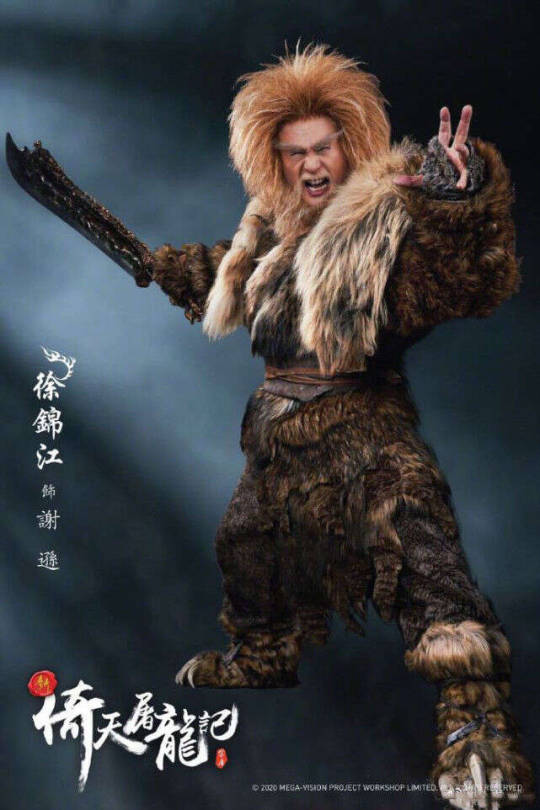
Oh, and while we’re at it, Gohan is likewise inspired by another character from a Louis Cha novel: the Prince of Dali Duan Yu in the Kung Fu novel Demigods and Semi-Devils. The Prince in that novel is a naïve, pacifistic scholar who prefers books to fighting, and who was raised to be timid and avoid combat, absolutely out of step with his family, all of whom are martial artists and warriors. In fact, the beginning of the story is the prince gets incredibly lost in the wilderness, where the hopelessly naïve prince is utterly out of his depth, with all the robbers and scary beasts, and needs to be saved by real martial artists that protect him like fairy godparents. He spends the first part of the story running away from everything, scared as hell. However, by circumstance, he has naturally high power he cannot fully initially control, and eventually realizes that even scholars and others who hate fighting have to sometimes become fighters to protect those they love.

The Duan Yu part of Demigods and Semi-Devils was made into a film, the Battle Wizard, which was reviewed by PewDiePie. The Dragonball similarities went over his head because, honestly, PewDiePie does not strike me as a perceptive person.
Hit was based on the screen persona of Chow Yun Fat.
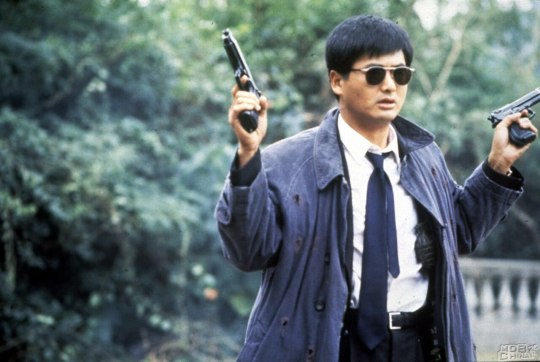
Chow Yun Fat was a Hong Kong cinema superstar who was to director John Woo what Robert de Niro was to Martin Scorsese. There are three giveaways that Hit was based on Chow Yun Fat. One, he’s an assassin, same as Chow Yun Fat’s character in the Killer, and is even given a sequence that’s a John Woo homage with an assassination in an office building with guns pulled on an empty elevator in an act of misdirection. Second, he’s wearing the single piece of clothing Chow Yun Fat is associated with, a black trenchcoat (fun fact: in Hong Kong today, trenchcoats are called Brother Mark Coats, after Chow Yun Fat’s character in John Woo’s A Better Tomorrow). Third, his power is essentially bullet time, a visual technique refined by John Woo in Hong Kong in the 80s and 90s in his gunplay triad movies starring Chow Yun Fat (what, you think the Wachowskis invented it?).
The Goku/Vegeta relationship is from “Legend of the Condor Heroes.”
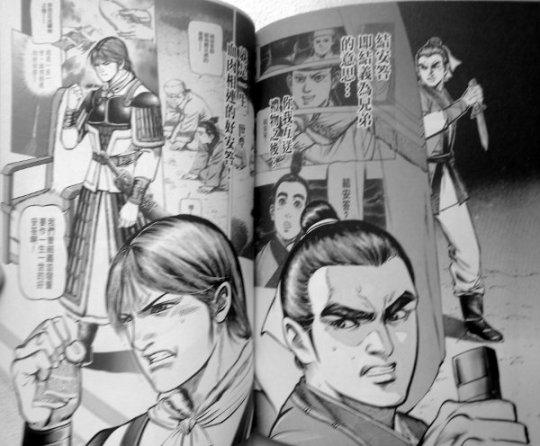
Here’s a story you might have heard before. It’s about two rivals, but by circumstance, one is raised in the wilderness beyond civilization, where he becomes an honest and goodhearted, though overly naive bumpkin, martial arts prodigy. The other is raised a wealthy prince by a conquering enemy, who grows up to also become an armor wearing martial arts expert, but also a cunning, arrogant, emotionally distant sociopath.
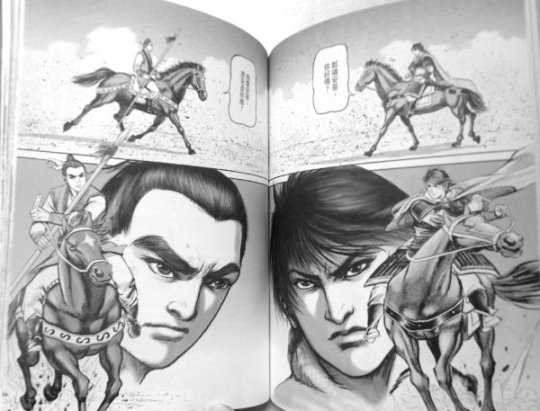
The similarities go into their love lives, too. The unsophisticated bumpkin hero is betrothed to a daughter of a powerful bearded barbarian king against his will, while the one hint of vulnerability and loss of emotional detachment in the otherwise sociopathic prince, the crack in his smirky arrogance, is that he loves a girl he otherwise pretends to hate, and even fathers a child with her who becomes a main character later.
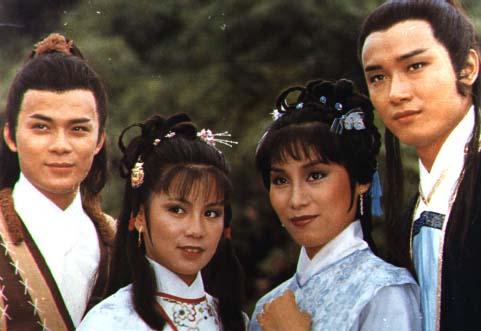
This is Guo Jing and Yang Kang from Legend of the Condor Heroes. The most fascinating similarity, and proof that female psychology is the same all over the world, is that the fangirls love the emotionally distant, arrogant, and sexy/evil prince (remember when Rhonda Rousey said her first crush was Vegeta?). Girls everywhere love bad boys and sexy villains, and oh boy, do they love Prince Yang Kang. I think you can probably guess who all the fan art is about for Legend of the Condor Heroes, and what ship is the most popular.

I have to emphasize that Legend of the Condor Heroes, which came out in the 1950s-60s, is possibly the most widely read novel by the most widely read novelist on earth - the sales on that dwarf Twilight and Harry Potter. It’s probably not an exaggeration to say nearly every Chinese person, even if they never read it, knows who these characters are. In fact, Yang Kang and Guo Jing from Condor Heroes are basically repeated over and over in Asian, Chinese, and Japanese culture. Does the unsophisticated but gifted martial arts prodigy bumpkin hero, and the glib, arrogant wealthy prince rival remind you of….another duo of rivals?
Gohan/Videl comes from Little Dragon Maiden

One of the most important and influential Martial Arts novels of all time is “Return of the Condor Heroes.” A sequel to Condor Heroes, this time, the main character is the teenage son of one of the main characters from the first novel. It gets even more familiar from there.
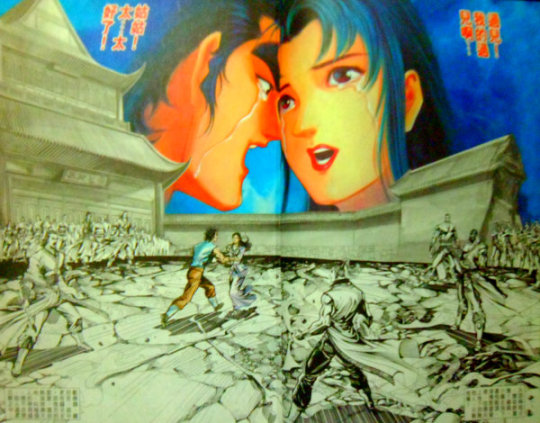
“Return of the Condor Heroes” was about a martial arts couple who are also master and student, the same age but vastly different in experience and skill so one somehow seems “older,” and they fall in love because the circumstances of training together requires they spend lots of time together and become intimate. The training story and the love story are exactly the same in “Return of the Condor Heroes.” The dead giveaway one story inspired the other is that in both, the most significant training sequence is one where the master teaches the student how to fly (though Return used a chamber of sparrows for lightness Kung Fu).

There are some differences of course – obviously in Return of the Condor Heroes, the genders of teacher and student are flipped from Gohan and Videl (it’s the Little Dragon Maiden who is a powerful teacher, and the boy who is the student). It was the girl (Videl) who was a rebellious delinquent in Dragon Ball Z, when it was the opposite in the novel, true. But it was obvious this story was in the back of the creator’s mind as a way to combine Kung Fu with the love story, by making teacher and student lovers.
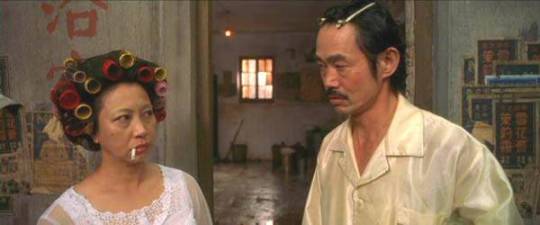
Addendum: hey, remember that awesome movie Kung Fu Hustle, the one Hong Kong movies normies have seen? Well, remember the landlord and landlady? The landlady was named Xiao Lung Nu, or Little Dragon Maiden, and her husband was named Yang Guo – the same as the main characters in Return of the Condor Heroes. It was a joke that went over the heads of Westerners, by giving these names of attractive and naïve young people in love with each other to a surly, bitter, arguing and chain smoking middle aged couple who don’t give a damn.
Going Super Saiyan comes from “Reincarnated” aka “Bastard Swordsman.”

Stop me if this sounds familiar: a terrifying warlord tyrant prone to killing underlings who displease him has achieved a level of skill and cultivation so tremendous nobody can stop him. But there is one, and only one, thing he fears and that can defeat him: a long-lost legendary skill that nobody has achieved in recent memory, that includes a supernatural combat power transformation that turns the hair light to indicate it worked.

This is “Silkworm Skill” from Reincarnated aka Bastard Swordsman, a novel and TV series from Hong Kong in the early 1980s. Of course, there are differences. To get the power boost and new hair color, the hero has to jump in a cocoon he weaves himself. In fact, the scene is so well known that they actually have it on the poster.

(To those saying “Super Saiyan turns your hair blonde, not white” my response is that it turns hair white, or uncolored, in the comic book.)
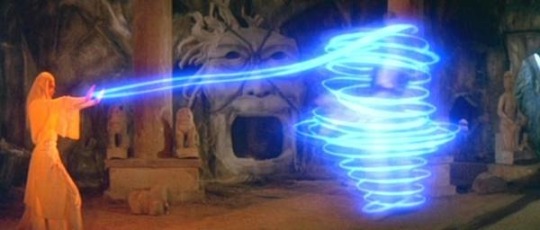
The idea of your hair turning white to indicate a new supernatural combat transformation or martial state wasn’t created by Bastard Swordsman, though – though it is the best example and probably the one most familiar to a 1980s audience due to the hugely popular books and TV series. For an older example, a famous Chinese movie based on a folktale is “Bride With the White Hair,” about a bride who’s hair turns white when she is betrayed, in her anger, she becomes less a woman and more a supernatural creature of vengeance (interesting that anger should be the means to unlock it).
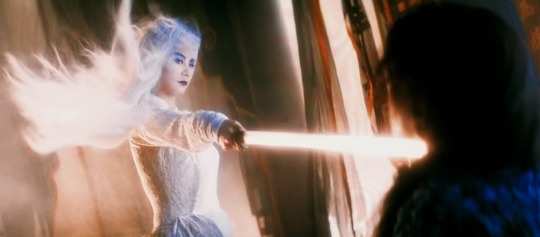
1K notes
·
View notes
Text
May the Four Forces Be With You!
May the force be with you? Much to learn you still have, padawan. In our universe it would be more appropriate to say, “May the four forces be with you.”

There are four fundamental forces that bind our universe and its building blocks together. Two of them are easy to spot — gravity keeps your feet on the ground while electromagnetism keeps your devices running. The other two are a little harder to see directly in everyday life, but without them, our universe would look a lot different!
Let’s explore these forces in a little more detail.
Gravity: Bringing the universe together

If you jump up, gravity brings you back down to Earth. It also keeps the solar system together … and our galaxy, and our local group of galaxies and our supercluster of galaxies.
Gravity pulls everything together. Everything, from the bright centers of the universe to the planets farthest from them. In fact, you (yes, you!) even exert a gravitational force on a galaxy far, far away. A tiny gravitational force, but a force nonetheless.

Credit: NASA and the Advanced Visualization Laboratory at the National Center for Supercomputing and B. O'Shea, M. Norman
Despite its well-known reputation, gravity is actually the weakest of the four forces. Its strength increases with the mass of the two objects involved. And its range is infinite, but the strength drops off as the square of the distance. If you and a friend measured your gravitational tug on each other and then doubled the distance between you, your new gravitational attraction would just be a quarter of what it was. So, you have to be really close together, or really big, or both, to exert a lot of gravity.
Even so, because its range is infinite, gravity is responsible for the formation of the largest structures in our universe! Planetary systems, galaxies and clusters of galaxies all formed because gravity brought them together.
Gravity truly surrounds us and binds us together.
Electromagnetism: Lighting the way

You know that shock you get on a dry day after shuffling across the carpet? The electricity that powers your television? The light that illuminates your room on a dark night? Those are all the work of electromagnetism. As the name implies, electromagnetism is the force that includes both electricity and magnetism.
Electromagnetism keeps electrons orbiting the nucleus at the center of atoms and allows chemical compounds to form (you know, the stuff that makes up us and everything around us). Electromagnetic waves are also known as light. Once started, an electromagnetic wave will travel at the speed of light until it interacts with something (like your eye) — so it will be there to light up the dark places.

Like gravity, electromagnetism works at infinite distances. And, also like gravity, the electromagnetic force between two objects falls as the square of their distance. However, unlike gravity, electromagnetism doesn't just attract. Whether it attracts or repels depends on the electric charge of the objects involved. Two negative charges or two positive charges repel each other; one of each, and they attract each other. Plus. Minus. A balance.
This is what happens with common household magnets. If you hold them with the same “poles” together, they resist each other. On the other hand, if you hold a magnet with opposite poles together — snap! — they’ll attract each other.
Electromagnetism might just explain the relationship between a certain scruffy-looking nerf-herder and a princess.
Strong Force: Building the building blocks

Credit: Lawrence Livermore National Laboratory
The strong force is where things get really small. So small, that you can’t see it at work directly. But don’t let your eyes deceive you. Despite acting only on short distances, the strong force holds together the building blocks of the atoms, which are, in turn, the building blocks of everything we see around us.
Like gravity, the strong force always attracts, but that’s really where their similarities end. As the name implies, the force is strong with the strong force. It is the strongest of the four forces. It brings together protons and neutrons to form the nucleus of atoms — it has to be stronger than electromagnetism to do it, since all those protons are positively charged. But not only that, the strong force holds together the quarks — even tinier particles — to form those very protons and neutrons.
However, the strong force only works on very, very, very small distances. How small? About the scale of a medium-sized atom’s nucleus. For those of you who like the numbers, that’s about 10-15 meters, or 0.000000000000001 meters. That’s about a hundred billion times smaller than the width of a human hair! Whew.
Its tiny scale is why you don’t directly see the strong force in your day-to-day life. Judge a force by its physical size, do you?
Weak Force: Keeping us in sunshine

If you thought it was hard to see the strong force, the weak force works on even smaller scales — 1,000 times smaller. But it, too, is extremely important for life as we know it. In fact, the weak force plays a key role in keeping our Sun shining.
But what does the weak force do? Well … that requires getting a little into the weeds of particle physics. Here goes nothing! We mentioned quarks earlier — these are tiny particles that, among other things, make up protons and neutrons. There are six types of quarks, but the two that make up protons and neutrons are called up and down quarks. The weak force changes one quark type into another. This causes neutrons to decay into protons (or the other way around) while releasing electrons and ghostly particles called neutrinos.
So for example, the weak force can turn a down quark in a neutron into an up quark, which will turn that neutron into a proton. If that neutron is in an atom’s nucleus, the electric charge of the nucleus changes. That tiny change turns the atom into a different element! Such reactions are happening all the time in our Sun, giving it the energy to shine.
The weak force might just help to keep you in the (sun)light.

All four of these forces run strong in the universe. They flow between all things and keep our universe in balance. Without them, we’d be doomed. But these forces will be with you. Always.
You can learn more about gravity from NASA’s Space Place and follow NASAUniverse on Twitter or Facebook to learn about some of the cool cosmic objects we study with light.
Make sure to follow us on Tumblr for your regular dose of space: http://nasa.tumblr.com
#nasa#star wars#universe#May the fourth be with you#space#science#atoms#life#particle physics#Sun#gravity#force#science facts#space science
6K notes
·
View notes
Text
The way people are reacting to wilbur’s latest lore stream (25/07/21) is… interesting.
I think a lot of people are forgetting that we see things the characters don’t. We get to watch from each of their POV’s, we learn their behaviours and their typical reactions to certain things. We learn how they think, how they act, and why they think and act in those ways. We know when something could negatively effect a character.
But the thing is, the characters don’t know each other the way we know them. It’s easy for us to spot red flags, to assign labels such as “evil,” or “good,” or “manipulative,” because we know every character, and we know them well. The characters don’t. They don’t know each other very well at all.
And so for us, we see a certain sentence tossed towards a character, and we know how much it will impact that character, but the other character doesn’t. The other character isn’t manipulating them, they’re not being cruel for the fun of it. They just only have their knowledge, and their experiences. It would be unrealistic and unfair of us to expect these characters to treat each other exactly how they need to be treated to progress and heal when these characters don’t know each other.
Also, characters can do bad things or things that hurt people without doing it on purpose. Not everything that has negative impacts on other characters is manipulative. As c!Ranboo said, people are a product of what they’ve been through. For example, sometimes c!Tommy lashes out with anger at people he cares about when his trauma response is activated. Afterwards, he might feel guilty and apologize about it, or act nicer. This isn’t manipulative; it’s a genuine trauma response that, while he is learning through therapy to deconstruct, is near-impossible to just, stop doing.
While I won’t jump to a diagnosis for c!Wilbur because cc!Wilbur hasn’t stated anything about it, and I’m not very knowledgeable on the subject, c!Wilbur is mentally ill. He exhibits extreme anxiety and paranoia, often making outlandish accusations that people are against him, or don’t trust him. It is very hard for him to trust people. He has also spent an incredibly long time alone, and I wouldn’t be surprised if that has twisted his view of himself and others.
All this to say, c!Wilbur does not have a very healthy idea of relationships. And I mean all kinds of relationships, his familial bonds with c!Fundy, c!Tommy, and c!Phil, his platonic relationships, all of it. He cannot trust someone if there is any chance they might betray him, and this often leads to him making relationships where he ends up on top, where he has the most control. This is also why he will often ask other characters to do extreme things to prove their loyalty to him.
Now, onto his interactions with c!Ranboo in the latest lore stream.
I genuinely believe that, for the most part, c!Wilbur was being genuine and honest with c!Ranboo. I do think he feels comfortable around c!Ranboo, like he actually understands him, and like he might understand c!Wilbur. Based simply off of his reactions and body language (big props to cc!Wilbur for that, really helps read the character), it seems that c!Wilbur was honestly, genuinely surprised by c!Ranboo, and felt a connection with him.
I mean, we ourselves have been rambling on and on about how similar these two characters are, how much they mirror each other. It’s not a huge surprise that the characters realized this as well. Like they said, they’re both thinkers.
“So what was that bit at the end, then? Why would c!Wilbur ask c!Ranboo if he trusts him, then ask him to blow something up, if not to manipulate him?”
Thank you, somewhat high-pitched voice, for asking! In my opinion, this is c!Wilbur’s skewed view of relationships shining through. He needs to know that c!Ranboo is on his side, will stick by him, because of the paranoia he experiences. Did he manipulate c!Ranboo into detonating the TNT? Well, yes and no. I don’t think it was intentional. He said beforehand, that it might have been a make or break for c!Ranboo. I think he need c!Ranboo to prove to him that he would stick by him, and having him act against c!Quackity confirmed to c!Wilbur that he would.
But looking at this from a different perspective, c!Ranboo was asked to commit an act of aggression against someone, under the knowledge that this would prove to c!Wilbur that c!Ranboo trusts him. And we know c!Ranboo is a people pleaser. We’ve known this since day one. He’ll go along with something someone says if he thinks it will make them like him or trust him. And so, while I don’t think c!Wilbur was intentionally manipulating c!Ranboo, I think c!Ranboo’s own traits sort of made it manipulation. C!Wilbur was picking at the part’s of c!Ranboo’s brain that make him go along with this kind of thing without knowing it.
Obviously, I’m biased towards both these characters. I want to believe the best of both of them, so my view on things may be a little skewed, but I tried to come at this with a neutral perspective. I probably got a few things wrong, or explained things in a bad way, but this is genuinely what I think is happening right now in the lore. I’m open to debate in the replies, but please be respectful and remember everyone is just doing their little human things enjoying a little Minecraft role play. :)
TLDR; I don’t think c!Wilbur is manipulating c!Ranboo on purpose, I think that the combination of their traits has lead to an unfortunate circumstance in which one requires others to go to extreme measures to prove he can trust them, and the other will go to extreme measures because he doesn’t want people to not trust him.
#I know i said i wouldn’t post an analysis on this but#it was too tempting#it just happened#it didn’t even mean to#whoops#wilbur soot#wilbur dream smp#wilbur dsmp#ranboo#ranboo dream smp#ranboo dsmp#c!wilbur soot#c!ranboo#dream smp#dsmp#dream smp analysis#dsmp analysis#Raine rambles
146 notes
·
View notes
Text
Adventure, 02, pragmatism, and humanism (morality of fighting, conflict resolution, the importance of personal choice, etc.)

Adventure and 02 are naturally very idealistic series, but despite being idealistic, there are times when they can get rather pragmatic -- even uncomfortably pragmatic in ways that seem a bit unusual for a kids’ show. The entire last quarter of Adventure and almost all of 02 dealt so heavily with the topic of “is it okay to fight, even if it means incurring deaths?" to the point it’s pretty hard to miss, but both series have an approach towards the morality of fighting, the possibility of potentially having to kill enemies (including former friends that have turned antagonistic), the approach to dispute resolution, and the meanings of “moving forward positively” and “not getting hung up on needless negativity” that are surprisingly nuanced. At times, there’s even a strong message that warns against getting hung up on preachy principles that sound noble on their face but actually don’t get anywhere in practice.
This is a handful of topics, and it’s to the point where it may seem a bit strange to condense all of these under one meta instead of dedicating separate posts to it, but I decided to on the grounds of the fact that they’re all very tied to each other in the course of Adventure’s narrative. Overall, both series are very kind to the feelings and mentalities and thoughts of the young children involved, having the characters not only be kind towards each other but also encouraging the audience to understand their feelings. This is an approach towards understanding oneself and others that happens to be very applicable to life in general, even for adults; both series float a balance of being pragmatic and yet humanistic, kind to the struggles and internal thoughts of all of the characters within, and have a surprisingly nuanced look at what it means to take part in conflict and what the “best thing to do” in such a case is.
As said above, this is a long and complicated meta, and it’s to the point where I’ve considered separating it into multiple parts or posts, but in the end could never bring myself to because of how interrelated all of these topics keep ending up with each other. So, to spare those of you who are intimidated by the sheer length and winding-topic nature of this, here are the main points:
One who is not emotionally ready to fight, or is unwilling to fight, should not be forced to fight. On top of it being inhumane, emotional exhaustion is treated much in a way similar to physical exhaustion; especially in a world where fighting strength is linked to emotional will, one whose heart is not in it will not even be able to effectively fight in the first place. Even when joining the fight is the obvious ideal solution, one who needs to sit out should not be blamed or scorned for it. A choice to fight is exactly that, a choice, not an obligation; the world is messy and imperfect, and the most you can do is try to do whatever you can within the best of your ability. If you do, there is no reason you should be scorned for it.
There are many meaningful ways to contribute to the overall fight that don’t necessarily involve direct physical violence; those ways are still valuable and necessary, and those more attuned to those roles should embrace those roles if it makes them more comfortable to do it that way.
If an extreme result -- such as killing the enemy -- is reached, it needs to be done with the first and foremost priority being to protect people and prevent casualties. A diligent effort should still be made to preserve as many lives as possible (which means this isn’t something where you get to go all “knight templar” and beeline for a violent solution) -- but sometimes, there will be times when push comes to shove and that most extreme solution will have to be reached, even if that “enemy” was originally a friend, because inaction will very obviously lead to more people being hurt.
When a dispute about important points like the above is reached, everyone’s feelings must be acknowledged. This is not to be confused with philandering around with a “both sides have a point!” compromise; in fact, Adventure and 02 both make very firm stances on the above issues. Rather, it makes it clear that said points need to be made while not invalidating the other person for having those feelings -- that is to say, there’s a huge difference between “your opinion is wrong” and “you are stupid and unreasonable for having that wrong opinion.” Dispute resolution and understandings can only be reached when you properly understand why the other person came to that conclusion, and treat them with proper empathy and compassion while you try to work it out. You don’t have to acknowledge their point, but you have to acknowledge their feelings. (For those of you who have seen Appmon: Shinkai Haru is a master at this technique, and there are multiple times during the series where he will very assertively make his case against others while still appealing to the other person’s feelings and never denying their right to have them. This is also an extremely useful technique for dispute resolution in general, and I recommend that those reading this consider employing it more often, at least assuming you’re dealing with someone who’s open to listening.) Likewise, to truly reach out to someone and support them also requires understanding their feelings -- you can’t truly “support” them unless you’re capable of doing so.
There is a certain limitation in which adhering too closely to “moral principles” ends up becoming impractical, and don’t end up contributing to anything in the long run -- fixating over things like grudges, revenge, “punishing” people, and even the concept of forgiveness can quickly turn into platitudes. The best way to move forward is to not fixate on those principles or get hung up on the past, and rather think “now that we’re at this point at the current moment, what’s the best way to move forward in a way that helps others the most and minimizes harm?”
Adventure and the morality of fighting, and the necessity of personal choice
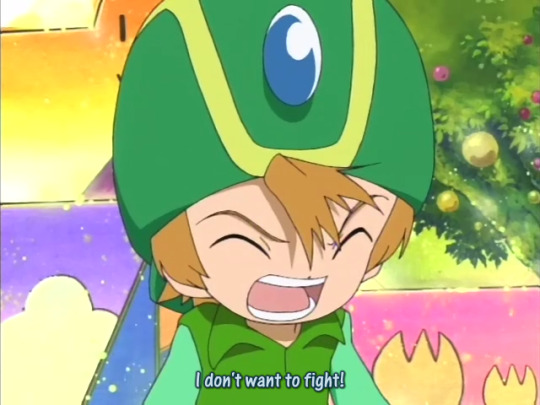
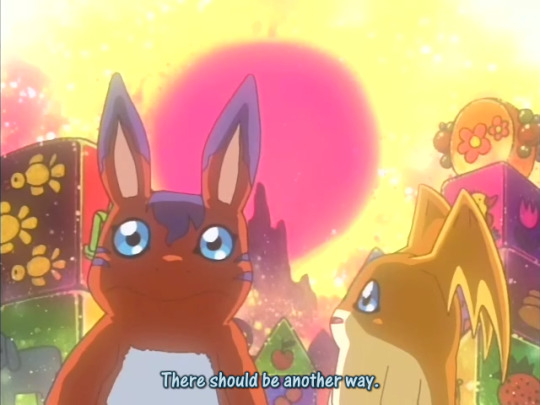

Believe it or not, the question of how feasible pacifiism is was first brought up as early as Adventure episode 12, when Takeru states that he has no intention of fighting Devimon. Elecmon calls this mindset out for the naivete of thinking they can just waltz up to Devimon and ask for answers instead of him trying to murder them on the spot -- and, in fact, he is completely right, because Devimon is not someone who can be reasoned with and indeed immediately tries to murder everyone on the spot one episode later, which results in Angemon’s death and Takeru trading out this very idealistic, naive mindset for the no-compromise, strict anti-darkness stance he takes in 02.
So there are two things to get out of this. The first is that, while Adventure and 02 are certainly very idealistic series, they are absolutely not naive. There are bad actors out there like Devimon who can’t be reasoned with whatsoever. Already off the bat, we have a clear statement from Adventure that an “everyone should stop fighting and get along!” mindset, when applied ad absurdum, is not going to get anyone very far.
The second is that none of the Adventure (or 02) kids like fighting. Takeru’s reaction here is certainly as extreme as it is because the idea of “fighting” presumably triggers his trauma from his parents’ divorce and the resulting split, but there’s no actual indication that any of these kids are necessarily fond of it. Certain ones like Taichi might get a little cocky midway through the battle when they’ve gotten it in the bag and are on an adrenaline high, but there’s also no indication that they’re interested in beating stuff up for the sake of it. Note that all of the fighting in Adventure episodes 1-10 was done out of sheer self-defense, and no Digimon was killed in any of the resulting battles (we’ll assume that the giant Bakemon in episode 11 doesn’t count mainly because it’s already dead) -- it was always fighting to the minimal amount to chase the attacking Digimon away or get them off their back. And, in File Island, that was possible -- but starting from the Server Continent and after, the hostile Digimon were actively out to kill them instead of just being territorial wild Digimon, forcing the Chosen Children to up the ante in order to survive.


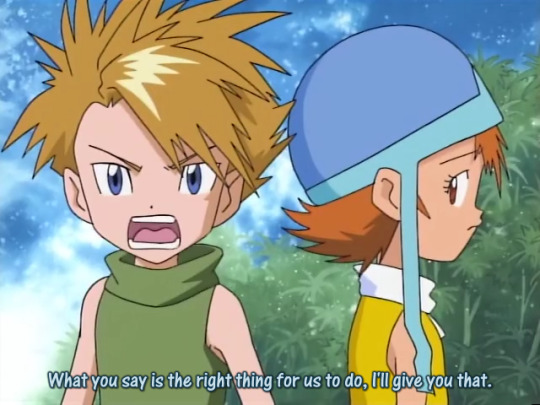

The issue of “whether fighting in itself is the right thing to do” is brought back in the Dark Masters arc, and this is also where we start getting a discussion about the disparity between “the right thing to do” and “whether one is capable of doing said right thing to do”. Mimi, the most emotionally sensitive of the group, starts having an emotional breakdown over whether they should keep fighting and potentially drag in more casualties -- especially because the Digimon that had died had all done it for their sake in order to continue the fight, and therefore the Chosen Children are indirectly responsible for their deaths. Yamato thus explains the difficulty of the situation: he himself agrees that Taichi’s evaluation of the need to push forward and continue the fight is the right thing to do, but it’s inhumane to not consider the stress and and emotional toll this is causing and force everyone to continue in spite of that.
In addition, Taichi’s reasoning for why they should continue is “revenge” -- a very negative, spiteful reason very tied to “fighting for the sake of it”. It’s understandable for Taichi to have these feelings, but he’s going at it from the wrong direction, and he’s overall being very insensitive in this scene. Later, in Adventure episode 45, he says that he’s doing it for the sake of honoring the Digimon who died for them. In other words, a lot of the reason Taichi’s methodology isn’t working is that he’s hung up on “the principle of things”, and not the more pragmatic reasons one should fight.
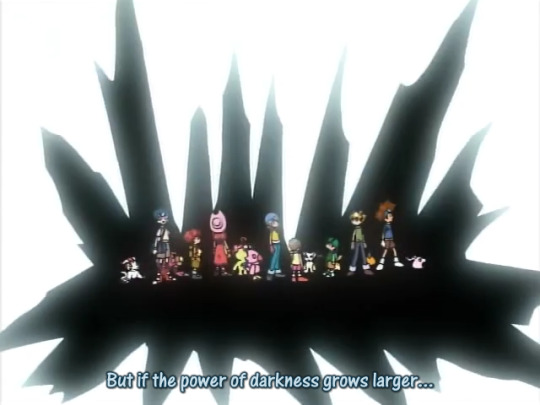
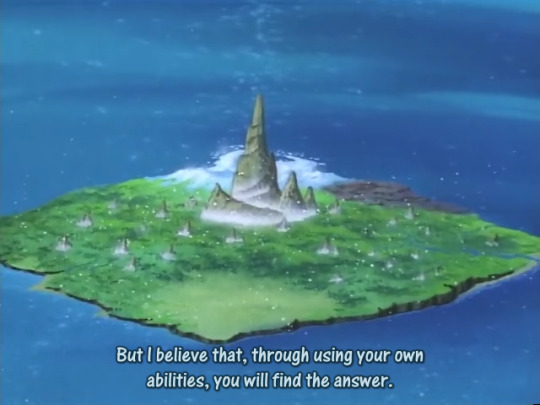
In Adventure episode 45, the kids finally meet the entity who chose them in the first place, who self-identifies as “the one who wishes for stability” -- the novels name them “Homeostasis”. Note the name -- it refers to the maintenance of internal balance within a living system, and Homeostasis themself starts their long infodump with their motive: it’s not that they want to eliminate all darkness from the world entirely, but that the powers of evil are upsetting the balance so badly that everything will be consumed if something isn’t done. It’s not like they’re insistent on violence either -- it’s just that they have a world to protect. The novels give us a particular amount of extra information on this entity, namely that it is not an omnipotent god by any shake of the imagination (in fact, there’s even an implication that there are higher powers that they themself don’t understand), and rather just a mere security system that observed that things were going south and used its rather limited methods of communication (via the Agents) to help make preparations.
Regardless, back to the episode -- we learn that the reason this entity recruited human children into all of this was because of the Hikarigaoka incident in 1995, which displayed to them and the Agents that a bond between children and Digimon could allow Digimon to evolve spontaneously, something that’s not possible with Digimon in the Digital World alone. Oh, and also, that they’ve been wanting to talk to them since File Island, and this entire thing about being cryptic with information was because they literally had no body and there was a massive amount of information loss after the Dark Masters blew up the Agents’ base and killed everyone except Gennai. In other words, just like with all of the actions the Chosen Children had been taking up until this point, everything Homeostasis and the Agents did was out of desperation because they were running out of other options to save their world, and during their brief time of being able to speak with the children, Homeostasis dumps pretty much everything they need to know and speaks to them using the extremely deferential sonkeigo form, meaning that they consider everything the kids are doing to be a massive favor to them. (Contrary to common belief, their possession of Hikari’s body does not seem to be non-consensual, given that they spend multiple episodes trying to contact her, and are clearly depicted having a proper conversation with her before temporarily borrowing her body.)
Most importantly, at the end of their speech, Taichi asks them what to do next, and the response is effectively: “We don’t know, but we trust you to make the best decision.” So, again: fighting as a Chosen Child is not an obligation, but something done because they want to do it and can. They were handed the tools to get this done by Homeostasis and the Agents, who believed in their potential to create miracles and be virtuous people and do something to save their world beyond what the native Digimon could do alone out of desperation and a lack of other options, and they are not hovering over the Chosen Children to see if they’ve “succeeded” or “failed” (note that they seem to have no sense of grudge or disappointment over Taichi’s SkullGreymon stunt in Adventure episode 16, explaining it very neutrally as an example of a risk), but more “we believe you were the best people who were able to do it and we trust your ability to help us.” (This is especially because, while it’s made clear they’d been wanting to contact them for a while, their most direct intervention comes right after Yamato had questioned why they were chosen in the first place -- presumably, they felt that the kids deserved an answer.)

At the end of Adventure episode 45, Mimi, considering the fighting they’re doing to be responsible for all of the fallouts and the sacrifices, decides that she won’t participate anymore, and Jou decides to stay with her in order to convince her to come back (although the novel also reveals that he himself is having doubts, too). Very importantly: nobody begrudges Mimi for being emotionally overwhelmed and sitting out, and nobody even begrudges Jou for choosing to stay with her. This is smack in the middle of the Dark Masters arc when everyone needs all the support they can get -- but after everything that had just happened, it’s inhumane to force either of them forward in this condition.
Despite his doubts, however, Jou himself is already coming to understand the limits of “pacifism” at a time like this:
What he wanted to tell her was this: that he didn’t see any likelihood of co-existing with the Dark Masters, and that they had no other choice but to fight them.
Even a neutral country like Switzerland had a military. They would be invaded by enemy countries without one. It would be nice and ideal if they used the nonviolent resistance approach as Ghandi did. But that didn’t mean it was okay to just be killed without lifting a finger…
But not even he could find a good answer.
Again: Adventure and 02 are an idealistic series, but they are not naive. It would be nice if the fighting could all stop and everyone would be happy, but there are malicious bad actors who will take advantage of you sitting there and doing nothing.

And so, Leomon dies in Adventure episode 47, and Mimi and Jou learn the hard way: if they do nothing, people will still die. Mimi had witnessed all of the Digimon sacrificing themselves for the Chosen Children’s sake, and thus had followed the logic that their friends would stop dying for them if they stopped fighting, but now that they’ve stopped fighting, said malicious forces (in this case, MetalEtemon) went ahead and killed their friends anyway -- and they’ve gone and destroyed the Village of Beginnings to boot, preventing any of them from being reborn. So in other words, if the intent is to “prevent casualties”, as it turns out, inaction didn’t actually prevent casualties.

Nevertheless, Mimi does not like fighting. In fact, Jou doesn’t like fighting either. Both of them now understand that it’s the best thing to do in this situation, but is it really the best thing to do to force them into embracing violence because of this? Instead, Jou determines in Adventure episode 50 that the overall fight doesn’t necessarily mean that everyone has to jump in and get violent -- the likeable and friendly Mimi has started to cultivate a skill in getting other people to rally behind her, and Jou is starting to consider that he may have a future in treating the wounded and supporting people before they become casualties. Those are still valuable ways they can contribute without forcing them into doing things they can’t bring themselves to do -- and, indeed, Mimi’s rallied army ends up saving everyone’s rears in Adventure episode 52.


While Taichi is not there to personally witness this discussion, Adventure episode 50 has him make a slightly less reckless tactical plan, and he explains (directly citing what happened with Yamato, Mimi, and Jou as his rationale) that he’s learned that he needs to take into account the potential for there being collateral damage. Recall that, earlier, his motive for doing things had been on a sheer principle level, with a lot of negative emotions of spite and revenge. But now, he’s come to understand that the most important thing he needs to do is to “prevent sacrifices”, and that’s the reason they still need to fight. Hence, why Taichi makes a proper plan for doing it instead of just doing the first and most aggressive thing that comes to mind, since he’s a soccer captain and has the potential for being a bird’s eye tactician, after all -- this time, he just needs to channel it in a way that prioritizes the lives of people around them.

And in Adventure episode 51, when reaching out to Sora (who’s cracking under all of her self-imposed expectations and sense of duty to others), Yamato and Jou take what they learned from Homeostasis six episodes prior and apply it -- Sora is working under the mentality that they have an “obligation” to get this done and that they are impending “failures” if they don’t (and, to be fair, if they don’t make it, the world is going to end, which is pretty unambiguously terrible). But what Yamato and Jou do is reframe it to fall more closely under the philosophy of what Adventure is saying here -- the fact they can do something about it is already absolutely incredible. (I mean, not to sugarcoat the fact that the world is still going to end if they pull it off, but the stress, self-hatred, and self-blame of “we’re failures for not pulling it off” is definitely not going to help.) They are doing everything they can right now, within their reasonable abilities. If they end up not being able to do it, that’s not something that should be considered a sin or a failure on their part; they are here because they can and want to and are doing it and are here to make the best possible use of that.
It’s one of the many times Adventure and 02 will make this statement, indirectly or directly: despite the title of “Chosen Child”, the Chosen Children do everything they do because of their own choices, and because they want to, not because they have to.


We finally meet Apocalymon in Adventure episode 53, and we learn that he(?)’s a combined spirit made up of all of the Digimon that were “eliminated” and failed during the evolution process, and is deciding to take out its anger and spite at the world out on everyone else by “denying evolution” (this is clarified in the novel to also be the reason it subtly influenced the prior enemies to destroy everything and especially the Village of Beginnings, because it functionally would put an end to the Digital World’s evolution by reducing it to nothing). So, in the end, we have a contrast between Apocalymon, who’s fighting for the sake of self-centered spite (including wanting to take down everything with it in Adventure episode 54 even when its demise is already clear), and the Chosen Children, who are fighting to protect their loved ones.

Incidentally, we also learn in Adventure episode 53 that there were Chosen Children who put an incomplete seal on Apocalymon prior to the ones in 1999. (Kizuna also introduces Menoa Bellucci, who became a Chosen Child in 1997, and assuming you’re following Adventure’s background doubling-every-year lore, at the time of 1999, there were a whole eight other Chosen Children besides Taichi’s group in existence.) The novels make it clear that the time dilation and distortion was going all the way up until the defeat of Apocalymon, long enough that the partners of those older Chosen were able to evolve to the Holy Beasts (and possibly enough for said older Chosen to get really faded through Digital World history to the point even Gennai doesn’t know about them). So the point here is that in the grand scope of the entirety of Digital World history, Taichi and his friends are not particularly singular existences -- there are people who saved the world before them, and 02 will introduce people all over the world who are going on their own adventures (including the main 02 kids in Tokyo), and, of course, by the time of the 02 epilogue, everyone’s going to have a Digimon partner. Koushirou later observes in Two-and-a-Half Break that there’s nothing special about having a partner in itself.
Does that make Taichi and his friends’ adventure of self-growth and saving a whole two worlds somehow insignificant, just because it’s not particularly unique? No. Because, again, they did this all not because of whether Homeostasis chose them or not, but because all of it was operated by their own will and strength and desire to protect others, all within the restraints of what they could feasibly do and handle, and they are amazing people for pulling that off.
02 and the importance of mutual understanding (and, also, more about the morality of fighting)

Before we proceed onto the 02 analysis, I think it’s important to establish a bit of important context about how 02′s lead protagonist, Daisuke, approaches things, and how it relates to the recurring debates on the morality of fighting throughout the series. In 02 episode 14, we learn that Daisuke was captured at Big Sight during the Odaiba Fog incident, and therefore witnessed, firsthand, the threat of Vamdemon’s lackeys attacking innocent civilians (something that Miyako, who witnessed the self-contained Omegamon vs. Diablomon battle on the Internet, and Iori, who only happened to be on a grounded plane after the Vamdemon fight had already ended, did not quite have anything on the par of). Spring 2003 and the Adventure novels elucidate what was going on in his head at the time: he was frustrated at his inability to protect his loved ones, and wished to have the power to fight the “bad guys” who were threatening everyone.
Remember this for later.
Moving onto 02 itself. 02 is a series about relationships, but, more significantly, it’s a series about the sheer amount of work it takes to maintain relationships, and especially the principle that “maintaining a relationship to another person requires being properly aware and understanding of the other person’s feelings.” One thing that often frustrates me about a lot of media (both kids’ shows and non-kids’ shows) and, well, to be honest, a lot of people in general, is the preaching of supposedly “positive” platitudes that actually go straight into what’s called “toxic positivity” for good reason -- because while it’s ostensibly “positive”, it also denies other people’s feelings, waving away everything negative and going “yeah, well, positivity!” and “optimism!” and “power of friendship!” and all sorts of stuff that are actually dismissive because they’re not showing any real effort to properly understand the other party and acknowledge why they feel this way. Like, sure, you may be telling someone to cheer up, but it also carries an (accidental or otherwise) implication of “you’re irrational and stupid for being upset and you should be smiling all of the time because ~positivity~.”
There is a lot of conflict in 02 -- especially because the theme of the morality of fighting is even more relevant, particularly in the case of the added question of “when the enemy in question is not an unambiguously evil sadist but a former friend in trouble”, and later the question of how someone who’s done horrible things in the past but is clearly making an active effort to make up for it should be treated. Daisuke, 02′s lead protagonist and carrier of a lot of its main themes, is ostensibly a simple-minded idealist, but even his theory of “positivity” and “always moving forward” has a lot of nuance beyond what you would usually see in this kind of anime lingo.



Context is also very important here. Adventure and 02′s stance being about “doing the best you reasonably can in a given situation”, it also means that what might be the best thing to do will change depending on context. 02′s starting circumstances are very different from Adventure’s, because it starts off without the threat necessarily being immediately world-threatening -- certainly, they need to stop the Kaiser, but this is in the form of a long-term territory war with an enemy who (at the time) doesn’t appear at night, and it’s unclear just how long it’ll take. This means that when the threat is not immediately world-ending, none of the kids are ever given grief for prioritizing their own personal obligations in lieu of fighting.
Iori and Jou do choose to ditch their kendo lesson and prep school exam (respectively), but they make it clear that they did this out of personal choice, and in fact this conversation opens with Armadimon apologizing to Iori for giving him grief for not coming, because he thinks Iori is perfectly within his rights to have stuck with the lesson! Perhaps, if the world were to end in a few hours, it would certainly be pretty idiotic to insist on sticking with a kendo lesson or prep school, because those things aren’t going to exist anymore if the world ends, but this is a very long and drawn-out territory war with no known end, and it’s understandable that these kids need to maintain their life necessities while straddling the balance between the war and their lives as a whole.
Again, they’re doing the best they can, and being a Chosen Child is about doing things because they want to, not because they have to.

This is especially because the Kaiser himself attempts to exploit the meaning of a Chosen Child in 02 episode 3 -- again, being a “Chosen Child” means being trusted to do the right thing with what you’re given, but the Kaiser basically betrayed that trust, and nobody was able to stop him from exploiting it and attempting a takeover with it. And Ken takes that title of “Chosen Child” and interprets it to mean he’s entitled to all of this -- but the other kids are Chosen Children just like him, and (at this point) all of them are simply choosing to do whatever they want with that.


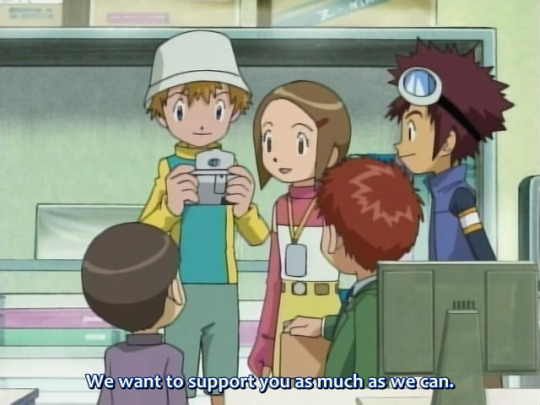
And on the flip side, you have the Adventure seniors, who are a little nerfed by the Dark Towers, but as far as the way the younger 02 kids see them goes, there is no doubt that the 02 kids respect them deeply and are practically reliant on their support and advice, and their experience and maturity in comparison to themselves. The episode that establishes most how in awe the 02 kids are of their seniors is 02 episode 17, where they learn the details of the adventure in 1999, and so it’s not about how much combat power they’re displaying right now but rather how much experience they have in doing such amazing things. Likewise, their seniors are frustrated at their inability to help -- not because they see it as some obligated duty, but because they see their juniors trying their best to deal with an ongoing crisis and want to help, resulting in them providing support roles such as covering for them with a camp trip in 02 episode 18 and allowing them to do a long-term Digital World stakeout. For this, the younger 02 kids adore them and give them all of their respect.


02 episodes 10-11 are significant in juxtaposing the themes of “conflict” and “understanding each other’s feelings” -- at the end of 02 episode 10, we see Yamato punch Taichi, but he holds his hand to him right after, indicating that Yamato punched him not out of anger or condescension or scorn over Taichi’s hesitation to fight Agumon, but rather simply to snap him out of it for his own sake, knowing he wouldn’t take it offensively, so in other words, what looked like a “conflict” on its face was actually communication between the two, with neither of them treating each other with scorn.
The conflict at the end of the episode is over whether they should run the risk of killing Agumon in the process of fighting him to get him back from the Kaiser’s Evil Spiral-induced brainwashing (note that this is about the risk, since it’s not necessarily guaranteed they’ll have to kill him, and they still of course need to make a conscientious effort to prevent that outcome). Yamato, however, frames it in terms of very practical matters, and even takes Agumon’s own feelings into it while he’s at it: if they pull back purely for the sake of not running that risk, Agumon will end up being the Kaiser’s slave and killing machine and nothing will be resolved, whereas if they run the risk, the best outcome is that Agumon is saved (which is, fortunately, what happens!), and the worst outcome is that he’s killed, which is still a preferable outcome to him having to remain the Kaiser’s brainwashed slave used to kill other things en masse.

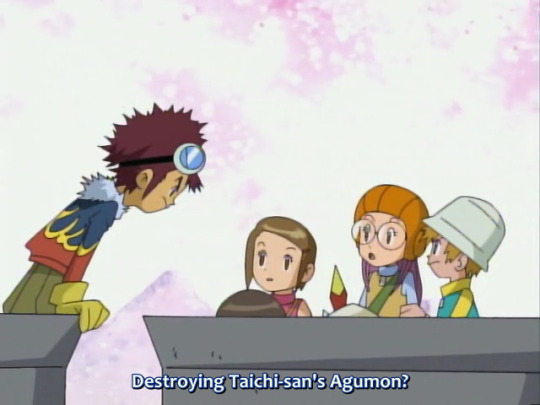


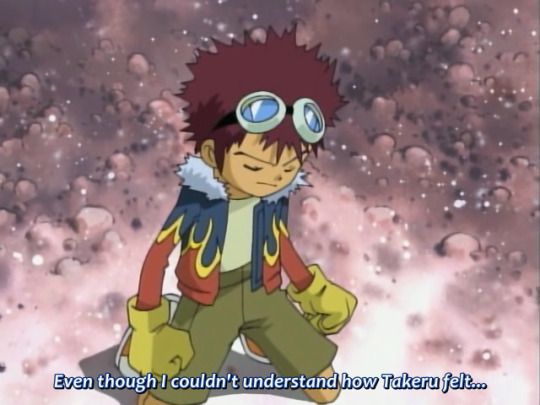
02 episode 11 further explores the theme of conflict in the face of “understanding each other’s feelings”, as it starts off with a fight between Daisuke and Takeru on the grounds of whether it’s okay to risk killing Agumon. Takeru’s stance is to side with Taichi’s decision, even if he doesn’t like it (again: just because some of these kids are able to make these decisions doesn’t mean they like it, and they’re doing it not because they’re callous but because they’ve thought hard about it and have decided it’s the best option they have!). Daisuke, being a bleeding heart, is appalled that Takeru could so easily endorse killing Taichi’s partner, and the two fight.
Note that the series does not “both-sides” this issue -- Taichi and Takeru’s stance is basically treated as the optimal course of action here -- but it also doesn’t invalidate Daisuke’s feelings of understandably being very shocked and appalled by this! Taichi and Yamato, in what initially seems like a violation of common sense, encourage them to be allowed to continue fighting, saying that it was essential to their friendship, and that confuses everyone present at the time -- but the meaning becomes clear by the end of the episode, when Takeru’s own Patamon is momentarily taken by the Kaiser and put at risk of himself becoming an Evil Spiral slave. Takeru blows up at Daisuke for hesitating (remember, this is one of his triggers), and eventually runs the exact same risk he’d advocated for Agumon with his own partner.
Remember what I said about “toxic positivity”? If everyone had just forced Takeru and Daisuke to shut up for the sake of “not fighting”, both of them might have remained angry at each other and stewing in silence, but because of the conflict, Daisuke himself personally witnessed Takeru run that risk for his own partner, presumably for the same reason (as much as the potential of Patamon being killed hurts him, the idea of Patamon being used as a killing machine is even more panic-inducing for him). With that, he understands that Taichi and Takeru made the decision to go ahead with this not out of callousness or cruelty, but because they sincerely felt they had to, no matter how much it pained them. Daisuke rails on himself for not understanding Takeru’s feelings better, and considering that he and Takeru never get in this vicious of a fight again, the point is: it wasn’t about whether they should form a friendship by fighting or not fighting in itself, it was about the fact that the two of them were able to get their feelings on the table, and that Daisuke was able to understand why Takeru endorsed what he did. (And this, too, is what it means for why Taichi and Yamato are friends now because they fought so much in the past -- back in Adventure, those fights ended up having them bare some very raw feelings to each other.)




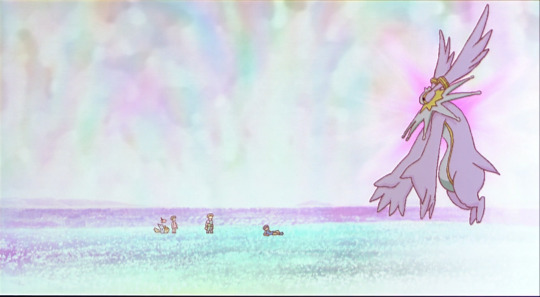
While in the series itself, they’re successfully able to save Agumon anyway, Hurricane Touchdown presents a more unfortunate outcome of the “friendly fire” debate, in which Daisuke learns that the hostile Digimon kidnapping their seniors (and, later, a lot of other people) is Wallace’s own partner. Daisuke is so emotionally overwhelmed by this that he breaks down crying at the possibility of having to kill someone’s partner, knowing that he’d never be able to do something like this if it were V-mon, and Wallace gets him on board with an attempt to appeal to Chocomon without fighting.
This stance is not unreasonable, Wallace and Daisuke cannot be blamed for being hopeful, and, in the end, it’s admirable that they did make a conscientious effort to solve this with pacifism (again, this kind of attempt should be made, and it’s not good to beeline to the most violent solution for no reason). But unfortunately, once they meet Chocomon in the flower field, it turns out that not only is Chocomon beyond reason, he himself is also clearly out of his right mind and suffering through all of this, and Wallace finally relents and asks Daisuke to assist him in the fight (after having stayed in denial for half a movie about wanting to avoid this). Daisuke, witnessing all of this himself, agrees without hesitation, and eventually, it turns out that this decision for the best when Chocomon himself begs Gumimon and Magnamon to put him out of his misery, and them obliging (albeit hesitantly) allows him to have peace in death instead of suffering in life.
Hurricane Touchdown’s sequel drama CD, The Door to Summer, presents Daisuke with yet another dilemma with Nat-chan, who is also clearly suffering in quite a similar vein (the parallel is directly drawn). In the end, the same conclusion is reached -- Nat-chan is unfortunately killed, but is able to find release.
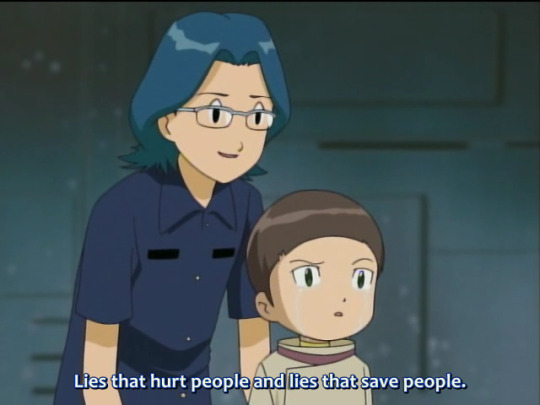
02 episode 16 presents an argument about the limits of ethical principles instead of approaching things practically, when Iori considers himself a horrible person for having told a lie to get Jou out of an important exam. This is mainly just about a lie, but in terms of Iori’s character arc and its relevance to 02′s themes as a whole, the point here is that there is a certain point where being too stuck on “the moral principle” of things instead of thinking practically is actually selfish in some sense. If Iori hadn’t lied, he’d get maybe one more point of moral integrity, and then everyone would have suffocated to death -- compared to lying and therefore everyone for the most part benefiting (Jou’s very happy to help his juniors and save them from, well, literally suffocating, after all). This topic becomes very important later when it turns out to be generally applicable to the wider morality of fighting that the kids later face in the series’s final cour.

The disparity between “moral principles” and “what actually happens in practice” also shows up in 02 episode 19, when Takeru loses his composure and starts punching out the Kaiser. Is the Kaiser a horrible person (at this point) who totally deserves this? Absolutely! Are we as the audience getting a lot of catharsis seeing his face punched out? Probably! But at the same time, railing at the Kaiser with unbridled anger is also...not actually accomplishing anything! Instead, Takeru’s just getting a few moments to stew in some really unhealthy emotions and uselessly punching out the Kaiser while nothing productive is getting done, and it’s also contributing heavily to his emotional isolation from Iori (and the rest of the group) because he’s not coping with it in a healthy way at all. Takeru’s feelings are certainly understandable (again: the episode is absolutely framing this in such a way that you’re inclined to take his side), but at the same time, being malicious about this is not actually practically making any headway.

One of the major reasons I’m covering all of these seemingly unrelated topics in one post is that all of them end up having a massive combined amount of relevance to the narrative behind Ken discarding the Kaiser persona, and how he comes to integrate himself with the group. On the surface, the storyline seems to be simply that Ken learned the error of his ways and tried to stop drowning in regrets, and Daisuke’s idealistic personality reached out to him and helped him heal. That said, there’s quite a bit more going on than just that.
A theme going on behind Ken’s character arc for the second half of 02 is one that probably seems a bit unusual for an idealistic kids’ show, but the point that ends up being made quite often is that whether Ken should be “forgiven” for his actions is a rather immaterial question. 02 episode 23 has a bunch of Baby Digimon rail on him, and remind him that he will never be able to take that back. There is nothing in either world that will erase those actions or make them retroactively justified or pushed under the bridge. The only thing he can do is accept the fact that it happened, whether he likes it or not, and determine what to do from here in terms of taking responsibility and making things right.
And this ends up having an influence in how Daisuke advocates for him, and how the rest of the group reaches out to him...

First of all, Daisuke being the most open-minded about Ken was not blind optimism. There’s no evidence that he was actually all that emotionally receptive to Ken or interested in being his friend before 02 episode 25. However, Daisuke also does not advocate for “punishing” Ken or kicking him while he’s down -- because that won’t accomplish anything, and Ken is clearly not in a state to be wreaking more havoc right now. Daisuke remembers the footage of Ken’s parents crying on screen, and determines what would be the first course of action to fix this situation -- and thus, he tells Ken to “go home”, because whatever Ken did in the past and no matter how much the team resents him right now, they are in this situation, with a boy who’s clearly not going to cause any more trouble right now and a family that’s hurting by his absence, and the very least he can do is do something productive from here on out.
Hence, at the end of 02 episode 24, when it turns out that Ken’s back and saved them from Thunderballmon, Daisuke decides to be optimistic about him and start the process of emotionally reaching out, but, again, it’s not blind optimism -- he sees what Ken did and takes this to mean “okay, clearly he’s not going to do bad things anymore, so regardless of whatever he did in the past, he’s helping out now, so we should check in with how he’s doing and let him help out.”
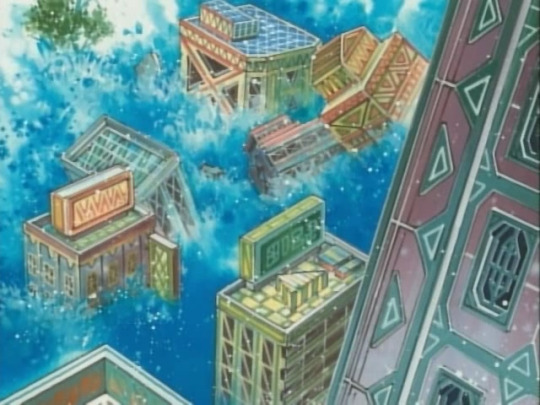

This is, of course, enhanced by the fact that Daisuke had communicated with the Crest of Kindness in 02 episode 20, but there’s also another layer to this: the major point of dispute between him and Miyako in 02 episode 25 (with both of them generally being rather open-minded about Ken otherwise) is in regards to the fact Ken and Stingmon were responsible for killing Thunderballmon in the prior episode. Come the climax of 02 episode 25, it is made clear that if Golemon successfully destroys the dam, the results will be absolutely disastrous, and there will probably be an incredible amount of casualties. Here, Daisuke himself is the first person to realize that killing Golemon may become a requirement (Ken is not actually a part of his initial comment) -- that is to say, most likely, the reason he’s willing to give Ken the benefit of the doubt about Thunderballmon is that he himself is understanding of that potential mindset (especially since 02 episode 43 does indeed establish Daisuke as being the first to accept it).
Recall that, between Daisuke, Miyako, and Iori, Daisuke was personally involved three years prior in a large incident with an unambiguously malicious Digimon that was about to claim a ton of victims -- he’s a bleeding heart, sure, but he’s also a bleeding heart for the potential victims, and the one thing that ate at him during the time of the Vamdemon incident was that he couldn’t do anything to protect everyone. Therefore, he’s the most receptive to this potential conclusion because he doesn’t want to see victims like that again. Not only that, Takeru and Hikari (having witnessed similar conclusions back in Adventure) are also very quick to point out that this might be an inevitability -- it’s just Miyako (who, in her emotional passion, is desperate to find a way out and clinging onto the hope that they won’t have to) and Iori (who considers doing such an act “no better than him” -- again, see the fixation on “moral principle” and “being above him”) who are so vehemently against it.
In the end, it turns out that Golemon is a Dark Tower Digimon (and therefore not sentient), and everyone’s left off the hook for now, but the reason this is still important is that through this, Miyako learns that Ken -- someone whom everyone was side-eyeing for potentially lapsing back into his cold, callous ways after supposedly having given up the Kaiser mantle -- was not out to kill (and, indeed, when the first kill inevitably happens in 02 episode 43, Ken is just as shaken about it as Miyako and Iori). The important part is that Miyako, and later the other kids, accepted Ken not out of some principle of optimism or forgiveness, but because they came to understand his position and feelings. All of the kids accepted Ken on their own terms after understanding his feelings and position better via interacting with him and hearing his own testimony -- they came to understand his mindset, what he’s been through and what he’s planning to do from here on out, and, most importantly, that he needs support really, really badly right now.
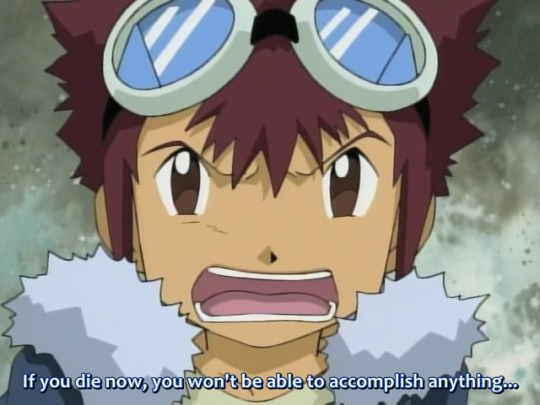

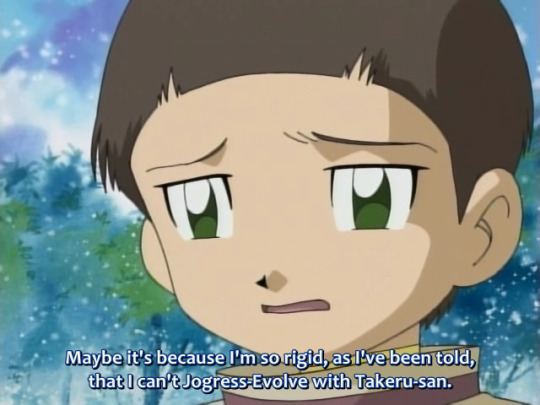
Which extends not just to Ken, but also everyone’s relationships here in general. Daisuke broke through to Ken and kicked off their first Jogress in 02 episode 26 because he proactively listened to everything Ken was saying and what he wanted to do, and correctly identified that Ken very desperately wants to take responsibility, so he talks him out of a reckless suicide mission by pointing out that all of his attempts to not make his family sad and to make up for everything he’s done are going to amount to nothing if he just throws his life away like this. In 02 episode 31, Miyako listens to Hikari’s troubles and her compulsion to not speak out for herself and reaches out to her successfully via promising to be there for her so she doesn’t have to slink into passive resignation. And in 02 episodes 34-36, Iori makes an active effort to understand Takeru’s mentality and why he has the drastic personality shifts he does, and communicates to Takeru that he wants to understand him better. So the point is: the 02 kids were able to successfully connect with each other and become deeper friends because they made an active attempt to listen to each other’s troubles and address the core of what they needed. They were only able to become “supportive” once they understood everything.
(02 episode 36 also has a moment where Iori’s about to rail off at everyone for not taking the fight seriously, before Armadimon reminds him that he’s starving -- again, it is very inhumane to ignore other needs and force everyone to keep fighting endlessly just because they theoretically can.)

We do meet the representative who claims credit for choosing Daisuke, Miyako, and Iori as Chosen Children in 02 episode 37 (Qinglongmon, representative of the Holy Beasts), and he explains the process of why they sent the kids what they did in order to retrieve Ken from the deep end. Notably, Qinglongmon admits that even the Holy Beasts were blindsided by a few things and adapted the situation as they saw fit (they didn’t originally expect the kids to be able to use multiple Digimentals at first). More importantly, this was, again, all a bit of a desperation move, because this was about as much as the Holy Beasts could manage, being sealed and drained of power and all.
Also, while retrieving Ken from the deep end was on the list of things the Holy Beasts set out to do, “everyone becoming Ken’s friend” was not necessarily on that agenda. Again: that was something that these kids chose to do on their own, by observing Ken’s actions and feelings and choosing to connect with him.
The episode ends with BlackWarGreymon going off on a journey of angst, and: note that the kids decide to drop the issue for the time being. Again, they’re operating not on a philosophy of grudge or whether one should get retribution for their actions, but what the likelihood of bad things continuing to happen is from here on out, and at this point in time, it doesn’t seem very likely, so there’s no point in pushing the issue or pursuing him.


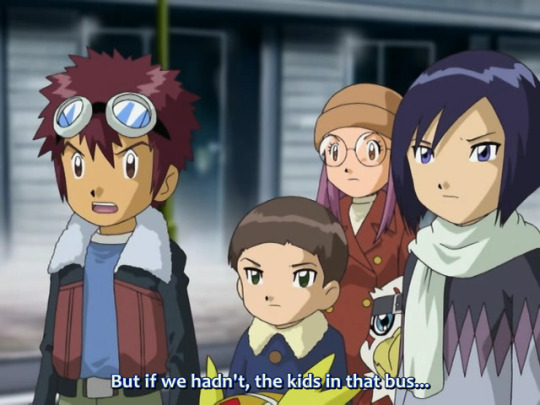
Nevertheless, the morality debate over killing still remains looming over everyone’s heads, with Iori also realizing in 02 episode 29 that there are such things as Digimon that just want wanton destruction and cannot be negotiated with. The fact that the Adventure kids were put in world-threatening situations three years prior and are already far past this question is directly acknowledged in 02 episode 43, with Taichi advising Hikari that this harsh truth is going to hit the other four sooner or later, before it does eventually happen at the end of the episode. (Hikari visibly winces during her conversation with Taichi; again, none of the Adventure kids ever liked this.) And, in the end, predictably, Iori, Miyako, and Ken take it hard -- but Daisuke is the first to point out what would have happened if they didn’t do it. Namely, that the victims would have far outnumbered the Digimon they just killed.
It is, of course, good to be conscientious and not beeline for the most violent solution, and, again, context is important here -- in the situation provided, SkullSatamon was holding up a bus and split seconds away from murdering everyone in it. Had everyone refrained for the sake of morality, just like how Iori refraining from lying back in 02 episode 16 would have actually been selfish in a sense, here, the only claim you get to say after refraining is “well, I wasn’t the one who caused the harm.” Inaction would have caused the deaths of all of the young children in the bus; there would have been casualties either way.
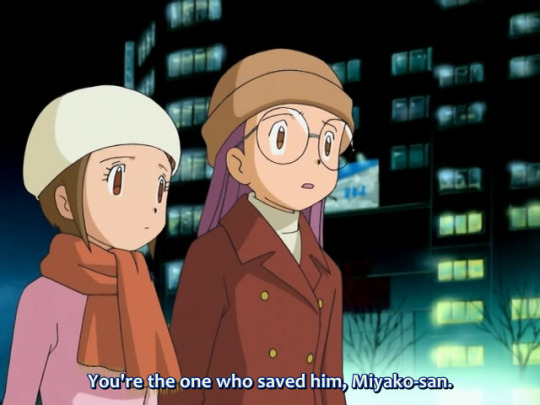

Miyako and Iori are forced to face this truth again in 02 episode 44, with both of them being emotionally compromised by the reality of what they just did. In both cases, Hikari and Takeru step in to remind them what they’re doing this for, by pointing out the victims that would have been killed had they done nothing. Miyako and Iori are not at fault for being emotionally compromised or doing their best to prevent it -- it’s just that there’s only so much they can blame themselves for when they’re now directly faced with the potential victims in front of them.
Iori had already been grappling with this potential for several episodes now, so while he still takes it hard, more attention is given to Miyako’s reaction -- especially since she herself was the victim who was about to be murdered by LadyDevimon had Silphymon not done the kill. The voice acting and lack of Tailmon’s presence in Silphymon’s apology to Miyako implies very heavily that it was the Aquilamon side who took over and did it in a last-ditch effort to save Miyako’s life -- and he’s emotionally destroyed by it himself too, because he did it out of love for Miyako, and yet betrayed her request to not go for the kill. In the end, Miyako is forced to confront the fact that this was done out of love and a desire to protect, not a callous and malicious intent to murder, and comes to terms with it.
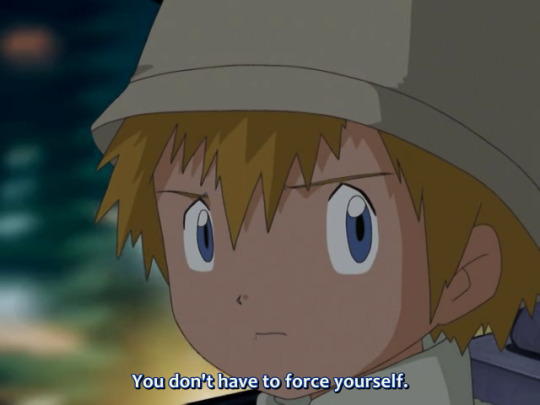
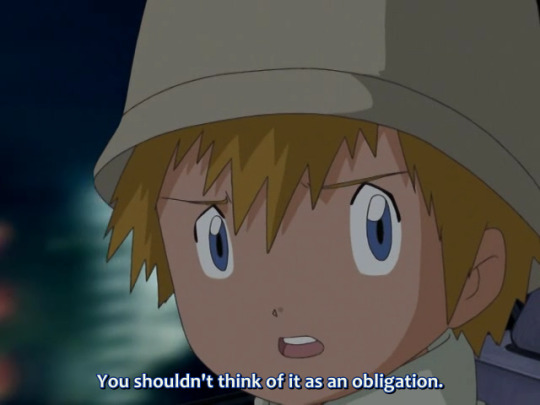

However, again: the series continues to reiterate that people who are not emotionally up for it should not be obligated to force themselves to do it. The beginning of 02 episode 45 has Takeru directly advise Iori that he shouldn’t do this out of obligation if he isn’t up for it -- remember that Takeru will only be able to fight with Shakkoumon if Iori is present, meaning that he’s perfectly willing to give up his ability to fight effectively because it’s not fair to force Iori to do it. This is not a series that advertises that everyone embrace the spirit of killing things and numb themselves to it. This entire situation sucks.
However, Iori makes it clear: he understands everything, and has decided to do it himself, because he understands the stakes and what it’s going to take to actually protect people.
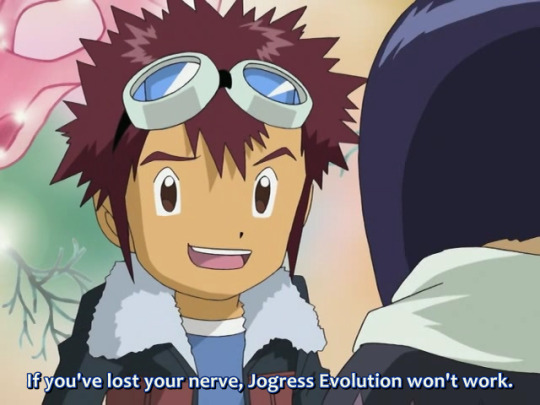
Which is also reiterated in 02 episode 48 -- after witnessing the deaths of Archnemon and Mummymon at the hands of BelialVamdemon, everyone is shaken to the core. It should be established that the kids didn’t have much reason to sympathize with or like the two of them at this point, because everything we learned about them was from the audience’s point of view -- as far as the kids knew them, they were just two really rude and cruel Digimon who wanted wanton destruction. Yet even they are emotionally pained to see them die in such a cruel manner, and it causes everyone to hesitate -- even Daisuke, who does push forward because he knows what’s at stake, but still has to take a moment to collect himself.
Seeing what Daisuke’s about to do, Ken tries to force himself to join Daisuke so that Daisuke will at least not be alone (note that he actually says upfront that he’ll join!) -- but Daisuke notices that Ken’s heart isn’t in it, and actively advises him to sit out. Is the world in immediate crisis? Absolutely! But there is no scorn to be had for people who are emotionally falling apart right now and unable to get themselves to do it -- Daisuke even says himself that they won’t be able to fight effectively with Ken like this.
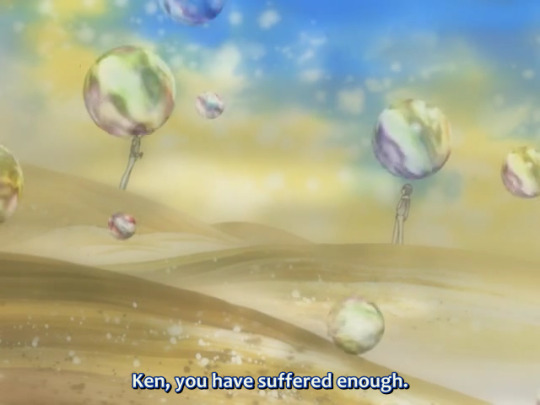

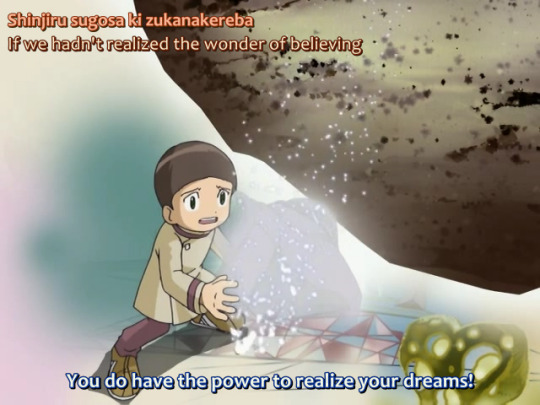
We close this analysis on a return to the concept of forgiveness and moving forward, and we learn in 02 episode 48 that Ken has two parts to his internal wishes: he wants the Kaiser (himself) to be “punished”, and he wants “forgiveness” from his deceased brother Osamu. Both of those things will certainly make him feel a little better emotionally, but they also won’t accomplish anything -- the “Kaiser” doesn’t exist anymore, so what good will that “punishment” do besides a little catharsis for the victims? And he can continue chasing after this standard of “whether he’s suffered enough” like it’s some numerical tally, but that’s not going to get him anywhere either, and it’s why Wormmon has to chase out even that ostensibly happy image of Osamu. Osamu is long gone, and is not going to return, and the question of whether Ken should be “forgiven” is rather immaterial. It’s not about whatever happened or didn’t happen back then; it’s about what Ken is going to do now.
Actually, what is “forgiveness” anyway? At no point do the 02 kids ever actually say they “forgive” Ken for his actions. In Spring 2003, Iori also says he doesn’t forgive Oikawa for what he’s done, either. There’s nothing that will ever erase what they did or suddenly make those actions retroactively justifiable, and there’s no arbitrary payment that Ken or Oikawa could do to meet some kind of quota of forgiveness. But what the kids do recognize in Ken is that, regardless of whatever he did in the past, at current he is a young boy in intense emotional distress who has gone through a lot, is working very hard to make up for his mistakes, and needs all the emotional support he can get, and there’s no reason to hold a grudge against someone like that instead of continuing to support him and loving him for who he is now. Given that, does it matter whether they “forgive” him or not?
And even if Iori will never forgive Oikawa, he can still lament everything that happened to him and drove him to do everything, and appreciate the meaning of what he did for the Digital World in the end, and use this as a further lesson on what it means to understand people instead of stewing angrily in a grudge that’ll only hurt himself.
Ultimately, that is the theory behind Adventure and 02. The world is messy, imperfect, and doesn’t fit under neat rules of morality and “right” or “not right” that you can cram everything under. Despite that, there’s something to be appreciated in not throwing in the towel and continuing to do the best you reasonably can in every situation. It would be ideal if all of the fighting could stop, or if it were possible to make the “optimal” decision of fighting or not fighting in every situation regardless of human exhaustion or emotional compromise, but that’s just not something that’s possible, and there’s no reason to call oneself a “failure” for not holding yourself to that standard. And in the end, the answer is this: instead of fixating on all of those arbitrary things that don’t actually serve any practical purpose, the way to live your best life is simply to look at where you are now, think about what you can do from here on out (regardless of what happened in the past), and do your best to protect and be kind to yourself and those around you.
Of course, you must be kind to others. But you have to be kind to others by understanding what it takes and everything around it -- and then choose to be kind anyway.
115 notes
·
View notes
Note
What if Bella and Rosalie swapped places
As usual, before we even answer this, I imagine this will go dark places.
Bella Swan is Rosalie
Bella is an attractive girl, there’s no doubt about that. The day she arrives in Forks she is immediately sought after by pretty much every guy she meets until her relationship with Edward (and then Jacob) becomes established. Bella doesn’t realize as much, actively thinks of herself as plain, and this is warped self-perception is a very large part of her character.
However, she’s not hands down the most beautiful woman in a city, not the way Rosalie was. (Not helping Bella with this is her introvert personality, which in American culture will make her stand out less and generally be less noticed, vs. Rosalie who very much sounded every inch the perfect socialite and life of the party.)
My point being, Bella will not have the same reputation in Rochester that Rosalie did, not appreciate the same level of attention even if she’s running in the same social circles, and likely will not attract Royce’s notice in terms of picking her out to be his bride.
I imagine Bella, while pretty, is very awkward at parties and has a very difficult time forming social connections with anyone. I imagine this causes significant angst for her family, who want her to go out there and be, well, Rosalie Hale.
She’s probably crushing hard on Edward Cullen, the doctor’s younger brother (or whatever Edward was posing as at the time, I forget if he’d drifted into Son mode yet).
And this is where we hit a cross roads.
Bella is Still Edward’s Singer
If Bella is still Edward’s singer, then we get Twilight, the period piece. Edward becomes obsessed, can’t read her mind, agonizes over her scent, and even without Alice’s help likely eventually decides he must be in love.
So he probably sneaks through her window but also does things like pretend to court her properly like a gentleman. Carlisle’s extreme frowny face about this but doesn’t have the heart to tell Edward what he already knows: you can’t marry this girl. Esme, of course, is fully supportive and tells Edward he can eat and or marry this girl, whichever floats his boat and will make him happiest.
Without the wolves, while Bella suspects there’s something not human about Edward, she will likely not stumble on “vampire” unless she has a precognitive dream (which is entirely possible). Regardless, like canon, she won’t care. She’s in love and has found the perfect man who will love her for who she is rather than who she isn’t. She dreams of marrying Edward like he’s an ordinary man and is more than down to be a vampire.
Likely, some incident happens, Esme probably loses control and tries to eat Bella. Edward demands they abruptly leave town, never mind that he’s been in the middle of courting Bella, THAT’S NOT IMPORTANT.
Bella is devastated and utterly destroyed, as she was in canon, but now there’s no Jake to help pick her back up, no wolves to divert her focus, but also no danger of other vampires.
There is a danger called Royce though. Probably, in search for Hallucination Edward, Bella walks the streets at night in a zombie like daze. She gets gang raped by Royce and pals and dies in agony.
Edward is too busy in Rio being miserable to find out. He breaks six months later, finds out she was brutally raped to death, and travels to Volterra where he gives Aro an aneurysm. He eventually forces their hand and they execute him for breaking the law.
If there’s no catalyst to make Edward nobly leave Bella’s side, then they might very well get married. Bella is probably able to pressure him into a wedding night, and then the Renesmee debacle happens. Only, without advanced medical equipment they’re resorting to Carlisle shoving dead animals at her. This probably doesn’t work and Bella likely dies in childbirth.
We end up in a similar timeline to this with probably similar results (Carlisle ends up in Volterra with a baby, Esme and Edward are god knows where).
Bella is Not Edward’s Singer
Then, as in canon, Edward likely finds Bella rather plain and overrated. Oh, she’s not as gossippy as some of the other women but she’s still a little girl and hardly worth his notice. Her mind is a bit of a mystery, but he likely eventually decides she must be simple, as he did with Charlie Swan.
If he notices her attraction to him, then it amuses and disgusts him, this girl has no taste.
She never really gets a chance to talk to him, and if she does, he’s a complete dick. Bella’s attraction likely cools severely (as it threatened to in canon after the Biology incident where he was utterly horrible to her).
Bella likely marries young. Probably to someone of notable wealth and social class, but not Royce. The marriage is probably all but arranged and she and her husband don’t get on or quite understand each other. Perhaps this changes in time but this requires significant character development for Bella.
Though, that said, Bella could be unfortunate and gang raped by Royce and pals. In which case, Carlisle might very well save her, and then Bella becomes the new almost Rosalie.
Edward doesn’t find her as vain, but he does likely find her vapid and made dumb decisions like walking down the street at night without an escort, what a fool. Like Rosalie, Bella intrudes on the thing he has going on with Carlisle and Esme, which he does not appreciate. Bella having the miraculous control she does, barely feeling the thirst and genuinely appreciating being a vampire and all the doors it opens for her (she gets to pursue education, is not tied down by marriage, gets to leave the worst of societal norms behind, etc.) likely only aggravates this for Edward. I imagine Bella becomes and remains his least favorite sibling.
Bella desperately tries to get along with Edward but quickly realizes any hopes of romantic attention from him are delusional and the best she can hope for is quiet tolerance in front of Carlisle and Esme. If even that. Bella still tries and all her attempts fall on their face.
Rosalie Hale is Bella
I imagine that Rosalie in the modern era, in a lower middle class family, will be a significantly different person. She’s probably a tomboy and I imagine an avid athlete and 4.0 all-honors student. Her favorite activities are probably fishing and hiking with her dad and she loves the Forks/Washington area. She’s still very pretty and usually ranked the most beautiful girl in X, but it’s not quite as important to her.
I imagine her vanity from canon instead translates to a perfectionist strive to be the best at everything she does. Rosalie’s aiming for the top.
That said, given Renee, I imagine Rosalie’s home life is complicated. Like Bella, it’ll be up to her to take care of most of the adult responsibilities with Renee from a very young age. Rosalie probably vastly prefers Charlie, but she can’t abandon her mother, at least not until Phil comes along to take care of her.
I also imagine Renee gets weird about Rosalie’s looks. Bella a pretty girl, but Bella notes that her mother is prettier and at the very least more outgoing. I think this suits Renee, it makes her the center of attention. With a child like Rosalie, she’d be overshadowed, and I don’t think she’d handle that well. And there would be these subtle, not-quite, jabs to remind Rosalie of her place and that Renee is important and beautiful.
This probably leaves significant marks on Rosalie, making her relationship with both her appearance and her mother very complicated.
Regardless, Rosalie ends up in Forks for probably similar reasons to Bella. Phil shows up, she sees she’s not needed anymore/in the way, she catches the first plane to Washington.
But, of course, nothing good comes from coming to Forks.
Rosalie’s looks will immediately capture Edward’s notice. Edward noted in canon that he did/does find Rosalie very attractive, he just hates her attitude about it. I imagine it will be similar here. He and everyone else will notice Rosalie immediately, but he’ll hate her because of it as well as because of her general personality. Rosalie is not his kind of woman.
Then we get to Biology. Edward may persevere as he did in canon but a) Rosalie’s not going to be into him at all ever after that b) he can read Rosalie’s thoughts. Neither of these things will be conducive to keeping her alive.
This will more than likely lead to Rosalie’s death.
#twilight#twilight meta#twilight headcanon#twilight renaissance#rosalie hale#edward cullen#anti edward cullen#bella swan#edward/bella#anti edward/bella#renee#meta#headcanon#opinion
121 notes
·
View notes
Text
So I saw this post while browsing toa tags the other day. While I don’t think being obsessed with the school mascot automatically makes Toby a furry (though it is funny to joke about lol) since “being a furry” actually just means “being a fan of anthropomorphic animals” and doesn’t necessarily require any form of costuming or interest in such, it did get me thinking, hmmm...if he was a furry, what would his fursona be? 🤔 And from there I started wondering what Jim’s and Claire’s would be as well because y not ¯\_(ツ)_/¯
BUT WAIT, I hear you say--haven’t you already drawn the trio as werewolves and wolfwalkers etc.? Wouldn’t those be their fursonas??
Well yes....but actually no.
I guess it’s a little hard to explain, but there’s a nuance between “[person] but as an animal” and a proper “fursona”. While a fursona is an animal character used to represent its person, it doesn’t have to physically resemble them at all as you would expect [person]-but-as-[animal] to. For example, if you were to design me but as a cat, you’d probably give it light brown fur and green eyes like I have irl. But my fursona, unlike my human self, actually has blue fur and purple eyes. You can give your fursona matching physical traits to your own if you want to, and some people do, but most use only a pinch of their irl appearance, if any at all.
The choices people make when designing their fursonas vary wildly from “it looks like me irl” to “it looks like who I want to be” to “I just really like this color scheme” to “this particular color/marking holds deep personal meaning to me” to “this particular pattern represents a particular defining moment in my life” to “idk it looks cool and i vibe with it” etc. etc. etc. Everyone has different reasons of varying depth for the decisions they make in designing their fursona.
Therefore, to design a fursona for Toby etc., it’s less a question of “what would this character look like as [insert species here]?” and more of “how would this character choose to present himself with his own [animal] character?”
And that’s a much trickier game than just transferring a character aesthetic to a new species. ^^; We have to kinda dive into the characters and makes some guesses about how they, if given infinite creative freedom to design an animal avatar with no rules or limits, would choose to present themselves.
So all that said, here’s what I came up with:
Starting with Toby because he’s the one who inspired the post. I think Toby might choose a wolfdog fursona. A lot of people who choose wolves as fursonas consider themselves to be overwhelmingly loyal to their friends, a trait that fits Toby very well. However, while Toby likes to be “cool”, I don’t think he really thinks of himself as much of an “alpha” type--he’s more of a sidekick, and he knows that, and he’s ok with that. He’s the wingman. So what better way to incorporate that than to add dog into the mix? Man’s best friend=Jim’s best friend. Sociable, humorous, and unwaveringly loyal. Wolfdog it is!
With the species decided, we can move on to the design itself.
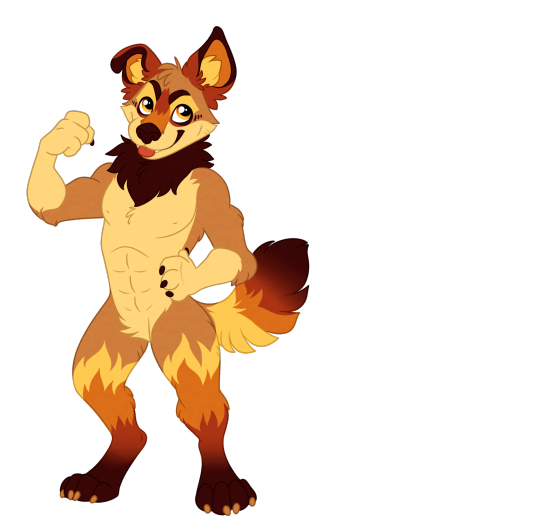
I can’t imagine any form of Toby in anything other than warm colors. This is extra emphasized by the flamelike patterns on his legs and tail, which both speaks to his desire to be totally awesome-sauce as well as acts as an allusion to his flaming warhammer. It’s fairly common (not universal, but common) for people to give their fursonas a more “ideal” physique than the person actually has as a sort of way to live by proxy physical goals or fantasies they’ve been unable to attain irl for whatever reason. Given that we’ve seen Toby struggle with fitness from time to time, it wouldn’t shock me to see him take this route. His wolfdog self is still relatively short and stocky, but it’s all muscle, babey.
This fursona is strong, fun, boisterous, and generally just kicks butt. Concentrated awesomesauce flows through his veins. Just don't mess with his friends, or you’ll feel the flames!
.
Moving on to Jim. Jim was the hardest to nail down, and most definitely the hardest to keep my personal biases out of oof. Which I may have failed to do anways because yes, ok, I made my favorite character a blue feline, sue me ¯\_(ツ)_/¯ But hear me out first!
For Jim I ultimately settling on a cheetah/lion hybrid.
Cheetahs, in a way, are sort of the underdogs (er...cats?) of the feline world--at least, in their local ecosystems. They are built wholly for speed, not strength--and as such, just about every other large predator in their environment has them beat when it comes to raw strength. Remind you of a certain Trollhunter? plus the long lanky legs. don’t forget those lol
However, because of this disadvantage, cheetahs...usually surrender. They know it’s not worth it to defend their kill from larger, stronger opponents, so they’ll give it up and just catch something else. This aspect doesn’t quite fit our protective, selfless protagonist all too eager to risk everything to save his loved ones--so a pure cheetah may not be the right choice.
So what animal is brave and protective? That’s where the lion part comes in, of course!
Why not just make him a pure lion? Well, a little similar to making Toby a wolfdog instead of a pure wolf. A straight-up lion feels a little too “chad” for our sweet Jimbo. Too much of a jock.
Jim has the humble underdog nature of a cheetah as well as the bravery and fierce protective drive of a lion. Cheelion? Leetah? idk, but let’s design it!

Like Toby and warm colors, I don’t think I can possibly associate Jim with any color but blue. While it’s never directly stated, given that we’ve never really seen him wear any other color (with the exception of the Eclipse armor), I think it’s pretty safe to assume that that’s his favorite. Blue sweater, blue jeans, blue shoes, even his backpack and bedsheets are blue. So naturally, his fursona would be predominantly blue as well! Plus some yellowish accents to (somewhat) match the natural colors of his chosen species(s).
I imagine he originally designed the character without horns, but then added them after becoming the Trollhunter, since it became such a major and impactful aspect of his life.
His lion’s mane also continues down his back in imitation of the “mantle” found on baby cheetahs. This youthful feature could subtly represent the fact that he’s been forced to grow up too fast and take on so much responsibility so young--so his fursona can still be young and carefree as long as he likes even while his real self struggles with the weight of the world on his shoulders.
This fursona is relaxed, calm, and confident. He’s not just cool--he’s crispy!
.
Lastly but not leastly, we have Claire. Out of the three, I think Claire was actually the easiest to choose--or at least, I had the clearest idea of what I thought she might go for.
Claire is a bit of an interesting duck, because while she’s shown to be fairly popular at school, she’s definitely far from the stereotype of The Popular Girl™. Yes she’s smart and pretty, but she’s also a little spunky or even a bit quirky--she’s a theatre kid, she’s a huge fan of hard rock band Papa Skull, and while I wouldn’t quite call her “rebellious” per se, she’s certainly willing to bend some rules if she feels the situation calls for it (not telling her parents that she was going to the concert with Steve, literally sneaking into Jim’s basement to try to find out what was up with him, etc).
That said, I think Claire might go for a hyena fursona--something a little out of the box, but not totally out of left field. (she also shows a slight Gurl Power™ streak here and there “the staff was not meant to be wielded by man--” “I am not a man!!!”) and if you know anything about hyenas...well, yeah lol)
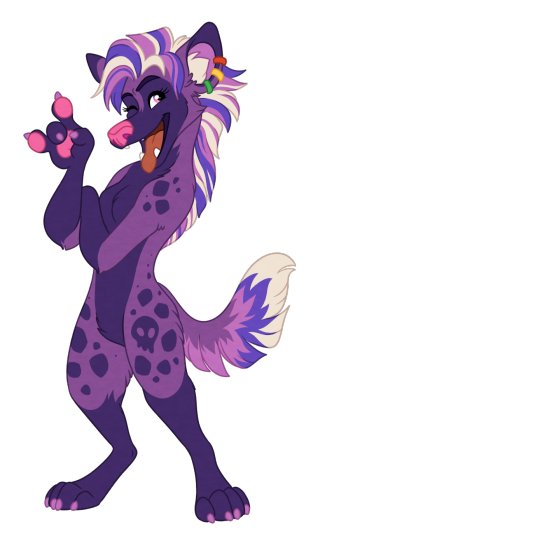
I think Claire would lean into her punk-rock “rebellious” side with her fursona design. This character is completely free of the pressure of being the councilwoman’s daughter and having to maintain her mother’s public reputation, and thus allows Claire to express a less restrained side of herself. She has a bold semi-edgy color scheme with bright accents (and some earrings to match her person’s hair clips) while still remaining feminine and (her own brand of) fashionable.
This fursona is spunky and sassy; she’s spicy and sweet all rolled up into one. She knows what she wants and she’s not afraid to chase it down. She lives her own life and she’s dang proud of it.
.
....sooooo yeah there’s my take on what Toby’s, Jim’s, and Claire’s fursonas could hypothetically be. And I guess since this post was inspired by a joke about Toby’s infatuation with the school mascot, here’s just some quick thoughts on how they might approach fursuiting to end us off:
Jim I don’t see as much of a suiter. He might try it once or twice if given the opportunity, but at the end of the day it’s not really his cup of tea--he’d rather act as the “handler” for his friends, if anything.
Toby and Claire, on the other hand, I could definitely see as suiters. In fact, with her interest in acting, Claire would probably particularly enjoy it--she’d be one of those suiters who really gets into character, absolutely refuses to break the magic publicly (outside of any actual medical emergency), and popular at cons because she just performs so well.
Toby, meanwhile, would be the more chill type--uses his normal voice in-suit, isn’t really too stressed about “breaking the magic”, just kinda hanging around like he would normally except “look I’m a talking dog, cool right?”.
also while I was typing this it occurred to be that since Eli is canonically a cosplayer then he could be a fursuiter as well; in his case i imagine he actually made his own suit it’s a protogen and it’s full of little LEDs and other electric gadgets, it’s not the prettiest thing ever as sewing is not his forte but boy did he try!! good for him. good for him
#so anyways I put way too much thought into this...enjoy I guess?#trollhunters#tales of arcadia#toby domzalski#jim lake jr#claire nuñez#furry#my art
63 notes
·
View notes
Text
Benzaiten Steel and the Fragility of Perception
or: reasons why setting boundaries is important #1283
I’ve figured out a reason why Benzaiten Steel stayed with his mother instead of doing the “sensible” thing and moving out. I think that it’s possible, too, that Juno has always been aware of the answer but, in the scope of Juno Steel and the Monster’s Reflection, he isn’t able to face it head-on because it contradicts his black/white, either/or sense of morality.
TL;DR: Despite Juno Steel’s unreliable narration we are able to see clearly the enmeshed relationship Benzaiten had with their mother Sarah and the ways in which that unhealthy family dynamic shaped Juno Steel as a person.
Sources: 50% speculation, 20% lit crit classes, 30% my psychology degree.
Juno’s perception of Ben is shallow and filtered through the limitations of human memory. We all know by now, too, that Juno’s an Unreliable Narrator™. In light of this, we need to ask ourselves why it is that Juno remembers Ben as happy, supportive, and only ever gentle in the challenges he poses to Juno. Throughout the episode, Ben’s memory is clearly acting as a comforting psychopomp: he ferries Juno through the metaphorical death of his old understanding of his mother (and also himself) and into a new way of thinking. He does this through persistent-but-kind questions, never telling Juno what to do or how to do it. This role could have been played by anyone in Juno’s life (Mick and Rita come to mind first) which makes it telling that Juno’s mind chose Ben to fill this role.
Juno’s version of Ben is cheerful, endlessly patient with Juno and Sarah, and above all he is compassionate. He acts as a mediating presence between Juno and Juno’s memory of Sarah and he doesn’t ask a whole lot for himself. If this is Juno’s strongest memory/impression of Ben’s behavior and perspective, then we can draw some conclusions about the roles they each played in the Steel family unit: Juno was antagonistic to Sarah and vice versa, and Ben was relegated to the role of mediator for the both of them.
Juno: She’s just evil.
Ben: That’s a big word.
Juno: “Evil”?
Ben: No, “Just”.
We can see in this exchange that Ben is a vehicle for the compassion Juno needs to show not only to Sarah but to himself, too, in order to move on and evolve his understanding of his childhood traumas.
This is not necessarily an appropriate role for a sibling or a child to hold in a family unit.
In family psychology, one of the maladaptive relationship patterns that is discussed is enmeshment. Googling the term you’ll find a lot of sensational results (e.g. “emotional incest syndrome”) that aren’t necessarily accurate in describing what this dysfunction looks like in the real world. This is in part because enmeshment can present many different ways. So, in order to proceed with this analysis of Benzaiten Steel’s relationship with his mom, I need to define enmeshment.
Enmeshment occurs when the normal boundaries of a parent-child relationship are dissolved and the parent becomes over-reliant on the child, requiring the child to cater to their emotional needs and to otherwise become a parent to the parent (or to themself and/or to other children in the family). This is easiest to spot when a parent confides in a child as if they’re a best friend, disclosing details of their romantic life, expecting the child to give them advice on coping with work stress, and similar. Once enmeshment occurs, any kind of emotional shift in one member of the enmeshed household will reverberate to the others; self-regulation and discernment (e.g. figuring out which emotions originate in the parent and which ones originate in the child) becomes extremely difficult for the effected child and parent. When an enmeshed child becomes an enmeshed adult they often have issues with self-identity and interpersonal boundaries. For example, they may struggle to define themselves without external validation and expect others to be able to intuitively divine their emotions. After all, the enmeshed adult could do this with their parent and others easily due to hypervigilance cultivated by their parent and they may not understand that such was not the typical childhood experience. These adults are often individuals to whom the advice “don’t set yourself on fire to keep someone else warm” is often relevant and disregarded. They may perceive their own needs as superfluous to others’-- and resent others as a consequence.
Another layer of complication is added when the parent in an enmeshed relationship is an addict, as Sarah Steel was. The enmeshed child often times becomes the physical caregiver to their parent as well and must cope with all the baggage loving an addict brings: the emotional rollercoaster of the parent trying to get clean or the reality of their neglecting or stealing from their child to support their habit or their simply being emotionally absent. Enmeshment leaves children with a lot of conflicting messages about their role in the family, how to conduct relationships, and how to define themself.
We only get an outside perspective on this enmeshment in the Steel family. It’s clear in the text that Juno’s relationship with his mother was fraught. He jokes in The Case of the Murderous Mask that she didn’t kill him but “not for lack of trying”, implying that Ben’s murder wasn’t the first time Sarah Steel lashed out at Juno-- or thought she was lashing out at Juno but hurt Ben instead. During the entire tenure Juno’s trek through the underworld of his own trauma, Juno asks the specter of Benzaiten over and over, “Why did you stay?”. This is a question that Juno himself can’t answer because Ben, when he was alive, probably never gave him an answer that Juno found satisfactory. There are a few possibilities, which I can guess from experience, as to what the answer was:
Ben may never have been able to articulate that his relationship with their mother left him feeling responsible for her wellbeing.
Or, if he ever told Juno that, Juno may have simply brushed off this concern. After all, as far as Juno was concerned, Sarah was only ever just evil. To protect himself from his mother’s neglect and codependence, Juno shut down his own ability to perspective-take and think about the nuances that might inform a person’s addiction, mental illness, abusive behavior, etc.
It is likely that Ben thought either his mother needed him to survive or, alternatively, that he couldn’t survive without her-- as if often the case with children who are enmeshed with their primary caregiver. It was natural and necessary for him, from this perspective, to stay. Enmeshment is a very real psychological trap.
It is often frustrating and hard as hell to love someone who is in an enmeshed relationship because, from the outside, the damage being done to them seems obvious. See: Juno’s assertion that Sarah was just evil. Juno is, even 19 years later, still angry about Sarah Steel and her failures as a parent and as a person. His thinking on this subject is very black-and-white. He positions Sarah as a Bad Guy in his discussions with Ben-the-psychopomp and the childhood cartoon slogan of “The Good Guys Always Win!” is repeated ad nauseum throughout Juno’s underworld journey. This mode of thinking serves two purposes:
First, it illustrates the role Juno played in the household: he was opposed to Sarah in all things and Sarah did not require any compassion or enmeshment from Juno. Juno was, quite possibly, neglected in favor of Ben which would create a deep resentment… toward both Sarah and toward Ben. This family dynamic would reinforce Juno’s shallow moral reasoning and leave him with vague, unachievable ideals to strive for like “Be One of the Good Guys” or “Don’t Be Like Mom” -- ideals that he can’t reach because he is a flawed human being and not a cartoon character, creating a feedback loop of resentment toward his mother and guilt about resenting Benzaiten. That guilt would further bolster Juno’s shallow memory of Ben as being infallibly patient, kind, loving, etc.
Second, Juno’s black/white moral reasoning is an in-text expression of the meaning behind Juno’s name. When “Rex Glass” points out that Juno is a goddess associated with protection, Juno immediately has a witty, bitter rejoinder ready about Juno-the-goddess killing her children. Juno was named for a deity who in some ways strongly resembles Sara Steel and he resents that he is literally being identified as his own mother. Juno-the-goddess has one hell of a temper, being the parallel to Rome’s Hera. Juno is not a goddess (detective) who forgives easily when she (he) knows that a child (Benzaiten Steel) has been harmed. This dichotomy of “venerated protector” versus “vengeful punisher” causes psychological tension for Juno that is only partially resolved in The Monster’s Reflection. The tension is not fully resolved, however, because Juno never gets a clear answer for the question, “Why did you stay?”
The answer is there but it is one that Juno doesn’t like and so can’t articulate: Ben is enmeshed with Sarah who named him, of all things, Benzaiten and that is why he stayed. We’ve already seen that names have intentional significance in the text. Benzaiten is hypothesized to be a syncretic deity between Hinduism and Buddhism, is a goddess primarily associated with water. Syncretic deities are fusions of similar deities from different religions/cultures; their existence is the result of compromise and perspective-taking and acceptance. Water, too, is forgiving in this way: it takes the shape of whatever container you pour it into... not unlike a child who is responsible for the emotional wellbeing of their entire family unit. Not unlike Benzaiten Steel.
Ben stayed with his mother because his relationship with his mother was enmeshed, leaving him little choice but to stay, and this ultimately led to tragedy. Sarah Steel’s failures as a parent are many and Juno still has a lot of baggage to unpack in that regard, especially where Ben is concerned. It’s unlikely that we’ll get the same kind of “speedrunning therapy” episode again but I know that The Penumbra is committed to a certain amount of psychological realism in its character arcs so I am confident in asserting that Juno Steel isn’t finished. Recovery is a journey and he’s only taken the first steps.
#juno steel#benzaiten steel#meta#the penumbra podcast#benten steel#sarah steel#psychology#enmeshment#bad parenting#iimpavid writes#chatter#the monster's reflection#the case of the murderous mask
311 notes
·
View notes
Text
Pagan Paths: Reclaiming

Many pagans and witches are also political activists. Pagan values — such as respect for the planet and for non-human forms of life, belief in equality regardless of race or gender, and personal autonomy — often lead people to social or political action. However, as far as I know, there is only one pagan religion that has actually made this social activism one of its core tenets: Reclaiming. Reclaiming combines neopaganism with anarchist principles and social activism.
This post is not meant to be a complete introduction to Reclaiming. Instead, my goal here is to give you a taste of what Reclaiming practitioners believe and do, so you can decide for yourself if further research would be worth your time. In that spirit, I provide book recommendations at the end of this post.
History and Background
Given Reclaiming’s reputation as a social justice-oriented faith, it’s not surprising that it grew out of activist efforts. Reclaiming began with well-known pagan authors Starhawk and Diane Baker, who began teaching classes on modern witchcraft in California in the 1980s. Members of these classes began protesting and doing other activist work together, and this pagan activist group eventually grew into the Reclaiming Collective.
Out of the founders of Reclaiming, Starhawk has probably had the biggest influence on the tradition. Starhawk was initiated into the Feri tradition by its founder Victor Anderson, but had also been trained in Wicca and worked with figures such as Zsuzsanna Budapest (founder of Dianic Wicca). These Feri and Wiccan influences are clear in Starhawk’s books, such as The Spiral Dance, and have also helped shape the Reclaiming tradition.
Like Feri, Reclaiming is an ecstatic tradition that emphasizes the interconnected divinity of all things. Like Eclectic Wicca, Reclaiming is a non-initiatory religion (meaning anyone can join, regardless of training or experience level) with lots of room to customize and personalize your individual practice.
However, to say that Starhawk is the head of the Reclaiming tradition, or even to credit her as its sole founder, would be incorrect. As Reclaiming has grown and spread, it has become increasingly decentralized. Decisions are made by consensus (meaning the group must reach a unanimous decision) in small, individual communities, which author Irisanya Moon calls “cells.” Each cell has its own unique beliefs, practices, and requirements for members, stemming from Reclaiming’s core values (see below). Some of these cells may stick very closely to the kind of paganism Starhawk describes in her books, while others may look very, very different.
As with any other religion, there are times where a governing body is needed to make widespread changes to the system, such as changing core doctrine. When these situations do arise, each individual cell chooses a representative, who in turn serves as a voice for that cell in a gathering with other representatives from other cells. BIRCH (the Broad Intra-Reclaiming Council of Hubs) is an example of this.
At BIRCH meetings, representatives make decisions via consensus, the same way decisions are made in individual cells. While this means changes may take months or even years to be proposed, discussed, modified, and finally passed, it also means that everyone within the tradition is part of the decision-making process.
Core Beliefs and Values
Like Wicca, Reclaiming has very little dogma. Unlike Wicca, the Reclaiming Collective has a public statement of values that clearly and concisely lays out the essentials of what they believe and do. This document, which is called the Principles of Unity, is not very long, so I’m going to lay it out in its entirety here.
This is the most recent version of the Principles of Unity, taken from the Reclaiming Collective website in February 2021:
“The values of the Reclaiming tradition stem from our understanding that the earth is alive and all of life is sacred and interconnected. We see the Goddess as immanent in the earth’s cycles of birth, growth, death, decay and regeneration. Our practice arises from a deep, spiritual commitment to the earth, to healing and to the linking of magic with political action.
Each of us embodies the divine. Our ultimate spiritual authority is within, and we need no other person to interpret the sacred to us. We foster the questioning attitude, and honor intellectual, spiritual and creative freedom.
We are an evolving, dynamic tradition and proudly call ourselves Witches. Our diverse practices and experiences of the divine weave a tapestry of many different threads. We include those who honor Mysterious Ones, Goddesses, and Gods of myriad expressions, genders, and states of being, remembering that mystery goes beyond form. Our community rituals are participatory and ecstatic, celebrating the cycles of the seasons and our lives, and raising energy for personal, collective and earth healing.
We know that everyone can do the life-changing, world-renewing work of magic, the art of changing consciousness at will. We strive to teach and practice in ways that foster personal and collective empowerment, to model shared power and to open leadership roles to all. We make decisions by consensus, and balance individual autonomy with social responsibility.
Our tradition honors the wild, and calls for service to the earth and the community. We work in diverse ways, including nonviolent direct action, for all forms of justice: environmental, social, political, racial, gender and economic. We are an anti-racist tradition that strives to uplift and center BIPOC voices (Black, Indigenous, People of Color). Our feminism includes a radical analysis of power, seeing all systems of oppression as interrelated, rooted in structures of domination and control.
We welcome all genders, all gender histories, all races, all ages and sexual orientations and all those differences of life situation, background, and ability that increase our diversity. We strive to make our public rituals and events accessible and safe. We try to balance the need to be justly compensated for our labor with our commitment to make our work available to people of all economic levels.
All living beings are worthy of respect. All are supported by the sacred elements of air, fire, water and earth. We work to create and sustain communities and cultures that embody our values, that can help to heal the wounds of the earth and her peoples, and that can sustain us and nurture future generations.”
The Principles of Unity were originally written in 1997, to create a sense of cohesion as the Reclaiming Collective grew and diversified. However, the Principles have not remained constant since the 1990s. They have been rewritten multiple times as the Reclaiming tradition has grown and the needs of its members have changed. Like everything else within the tradition, the Principles of Unity are not beyond scrutiny, critical analysis, and reform.
For example, in 2020 the wording of the Principles of Unity was changed to affirm diverse forms of social justice work — including but not limited to non-violent action — and to express a more firm anti-racist attitude that seeks to uplift BIPOC. This was a major change, as the previous version of the document explicitly called for non-violence and included a paraphrased version of the Rede (often called the Wiccan Rede), “Harm none, and do what you will.” This change was made via consensus by BIRCH, after a series of discussions about the meaning of non-violence and the need to make space for other types of activism.
Aside from the Principles of Unity, there are no hard and fast rules for Reclaiming belief. As Irisanya Moon says in her book on the tradition, “There is no typical Reclaiming Witch.”
Important Deities and Spirits
Just as with belief and values, views on deity within Reclaiming are extremely diverse. A member of this tradition might be a monist, a polytheist, a pantheist, an agnostic, or even a nontheist. (Note that nontheism is different from atheism — while atheism typically includes a rejection of religion, nontheism allows for meaningful religious experience without belief in a higher power.)
The Principles of Unity state that the Goddess is immanent in the earth’s cycles. For some, this means that the earth is a manifestation of the Great Goddess, the source of all life. For others, the Goddess is seen as a symbol that represents the interconnected nature of all life, rather than being literally understood as a personified deity. And, of course, there are many, many people whose views fall somewhere in between.
In her book The Spiral Dance, Starhawk points out that the deities we worship function as metaphors, allowing us to connect with that which cannot be comprehended in its entirety. “The symbols and attributes associated with the Goddess… engage us emotionally,” she says. “We know the Goddess is not the moon — but we still thrill to its light glinting through the branches. We know the Goddess is not a woman, but we respond with love as if She were, and so connect emotionally with all the abstract qualities behind the symbol.”
Here’s another quote from The Spiral Dance that sums up this view of deity: “I have spoken of the Goddess as a psychological symbol and also as manifest reality. She is both. She exists, and we create Her.”
In that book, Starhawk proposes a perspective on deity that combines Wiccan and Feri theology. Starhawk’s Goddess encompasses both the Star Goddess worshiped in Feri — God Herself, the divine source of all things — and the Wiccan Goddess — Earth Mother and Queen of the Moon. This Goddess’s consort, known as the God, is similar to the Wiccan God, but includes aspects of Feri deities like the Blue God.
For some, this model of deity is the basis of their practice, while others prefer to use other means to connect with That-Which-Cannot-Be-Known. Someone may consider themselves a part of Reclaiming and be a devotee of Aphrodite, or Thor, or Osiris, or any of countless other personified deities.
Reclaiming Practice
As I said earlier, Reclaiming began with classes in magic theory, and teaching and learning are still important parts of the tradition. The basic, entry-level course that most members of the tradition take is called Elements of Magic. In this class, students explore the five elements — air, fire, water, earth, and spirit — and how these elements relate to different aspects of Reclaiming practice. Though most members of the tradition will take the Elements of Magic class, this is not a requirement.
After completing Elements of Magic, Reclaiming pagans may or may not choose to take other classes, including but not limited to: the Iron Pentacle (mastering the five points of Sex, Pride, Self, Power, and Passion and bringing them into balance), Pearl Pentacle (mastering the points of Love, Law, Knowledge, Liberation/Power, and Wisdom and embodying these qualities in relationships with others), Rites of Passage (a class that focuses on initiation and rewriting your own narrative), and Communities (a class that teaches the skills necessary to work in a community, such as conflict resolution and ritual planning).
If you’ve read my post on the Feri tradition, you probably recognize the Iron and Pearl Pentacles. This is another example of how Feri has influenced Reclaiming.
Another place where the teaching/learning element of Reclaiming shows up is in Witchcamp. Witchcamp is an intensive spiritual retreat, typically held over a period of several days in a natural setting away from cities. (However, in light of the COVID-19 pandemic, some covens are now offering virtual Witchcamps). Because each Witchcamp is run by a different coven, with different teachers, there is a lot of variation in what they teach and what kind of work campers do.
Each individual camp has a main theme — some camps keep the same theme every time, while others choose a new theme each year. Some camps are adults-only, while others are family-oriented and welcome parents with children. Typically, campers will have several classes to choose from in the mornings and afternoons, with group rituals in the evenings.
Speaking of ritual, this brings us to another important part of Reclaiming practice: ecstatic ritual. The goal of most Reclaiming rituals is to connect with the divine by achieving a state of ecstasy.
Irisanya Moon says that Reclaiming rituals often use what she calls the “EIEIO” framework: Ecstatic (involving an altered state of consciousness — the transcendent ecstasy of touching the divine), Improvisational (though there may be a basic ritual outline, there is an openness to acting in the spirit of the moment), Ensemble (rituals are held in groups, often with rotating roles), Inspired (taking inspiration from mythology, personal experience, or current events), and Organic (developing naturally, even if that means going off-script). This framework is similar to the rituals Starhawk describes in her writing.
There are no officially recognized holidays in Reclaiming, but many members of the tradition celebrate the Wheel of the Year, similar to Wiccans. The most famous example of this is the annual Spiral Dance ritual held each Samhain in California, with smaller versions observed by covens around the world.
Further Reading
If you are interested in Reclaiming, I recommend starting with the book Reclaiming Witchcraft by Irisanya Moon. This is an excellent, short introduction to the tradition. After that, it’s probably worth checking out some of Starhawk’s work — I recommend starting with The Spiral Dance.
At this point, if you still feel like this is the right path for you, the next step I would recommend is to take the Elements of Magic class. If you live in a big city, it may be offered in-person near you — if not, look around online and see if you can find a virtual version. Accessibility is huge to Reclaiming pagans, and many teachers offer scholarships and price their classes on a sliding scale, so you should be able to find a class no matter what your budget is.
If you can’t find an Elements of Magic class, there is a book called Elements of Magic: Reclaiming Earth, Air, Fire, Water & Spirit, edited by Jane Meredith and Gede Parma, which provides lessons and activities from experienced teachers of the class. Teaching yourself is always going to be more difficult than learning from someone else, but it’s better than nothing!
Resources:
The Spiral Dance by Starhawk
Reclaiming Witchcraft by Irisanya Moon
The Reclaiming Collective website, reclaimingcollective.wordpress.com
cutewitch772 on YouTube (a member of the tradition who has several very informative videos on Reclaiming, told from an insider perspective)
#paganism 101#paganism#pagan#neopagan#reclaiming#reclaiming witchcraft#starhawk#irisanya moon#goddess worship#witchblr#witch#witchcraft#witchy#baby pagan#baby witch#anarchy#activism#environmentalism#long post#my writing#mine
95 notes
·
View notes